Coffee Culture Around the World
Discover Letino – Your Guide to Vibrant Culture

Did you know that Letino, a charming village in the Campania region of Italy, is steeped in rich history and vibrant culture? With its picturesque landscapes, medieval architecture, and warm hospitality, Letino offers an authentic Italian experience like no other. Whether you’re exploring the narrow cobblestone streets, indulging in delicious local cuisine, or immersing yourself in the village’s cultural heritage, Letino is a hidden gem waiting to be discovered.
Key Takeaways:
- Letino is a charming village nestled in the heart of the Campania region in Italy.
- Visitors to Letino can immerse themselves in authentic Italian culture and hospitality.
- Letino offers picturesque landscapes, medieval architecture, and delicious local cuisine.
- The village is rich in history, with its narrow cobblestone streets and cultural heritage to explore.
- Letino is a hidden gem that provides a truly enchanting experience for travelers.
Things to Do in Letino
In Letino, there are plenty of things to do to immerse yourself in the local culture and experience the natural beauty of the region.
Visit the Church of San Nicola: Immerse yourself in history and marvel at the beautiful architecture and intricate frescoes of this medieval church. Discover the remarkable craftsmanship and artistic expressions that adorn its walls.
Explore the Matese Regional Park: Embark on a nature adventure in the Matese Regional Park, where you can hike through scenic trails, wander through lush forests, and encounter picturesque lakes. Immerse yourself in the beauty of Letino’s natural landscapes.
Letino Museum: Discover the rich cultural heritage of Letino at the Letino Museum. Explore exhibits that showcase the traditions, costumes, and artifacts that reflect the village’s history and cultural identity.
With a range of attractions and activities, Letino offers something for everyone, whether you’re a history enthusiast, nature lover, or culture seeker.
Letino Cuisine
When it comes to food, Letino is a culinary paradise. This charming village offers a wide range of delightful dishes that will tantalize your taste buds and showcase the flavors of the region. Whether you’re craving traditional Italian cuisine or want to indulge in international flavors, Letino’s restaurants have something to offer for everyone.
The Authentic Mexican Delights of Nuevo Leon
If you’re in the mood for authentic Mexican cuisine, look no further than Nuevo Leon. This vibrant restaurant in Little Village serves up mouthwatering dishes that capture the essence of Mexico. From flavorful tacos and enchiladas to sizzling fajitas and refreshing margaritas, you’ll find a true taste of Mexico in every bite.
Tres Leches Cake at Kristoffer’s Café & Bakery
No visit to Letino would be complete without trying the famous tres leches cake at Kristoffer’s Café & Bakery in Pilsen. This light and moist sponge cake soaked in a sweet milk mixture is a local favorite. Indulge in a slice of this heavenly dessert and experience a true culinary delight that will leave you craving for more.
Savory Delights at 5 Rabanitos and Carnitas Uruapan
If you’re in the mood for savory dishes, head to 5 Rabanitos or Carnitas Uruapan in Pilsen. At 5 Rabanitos, you’ll find a menu inspired by Mexican street food, featuring flavorful tacos, tamales, and ceviche. Carnitas Uruapan specializes in succulent slow-cooked pork carnitas that are tender and packed with flavor. These restaurants offer a true taste of Letino’s local cuisine and are a must-visit for food enthusiasts.
Savor Puerto Rican Flavors at Nellie’s Restaurant
For a taste of Puerto Rican cuisine, make sure to visit Nellie’s Restaurant in Humboldt Park. This cozy eatery serves up classic Puerto Rican dishes that will transport you to the beautiful island. From mofongo and arroz con gandules to flavorful empanadas and tostones, Nellie’s Restaurant offers an authentic Puerto Rican culinary experience that will satisfy your cravings.
Whether you’re a food lover or someone looking to explore different flavors, Letino’s diverse culinary scene has something to offer for everyone. From Mexican delights to Puerto Rican flavors, Letino’s restaurants will take you on a culinary journey that will leave you craving for more.
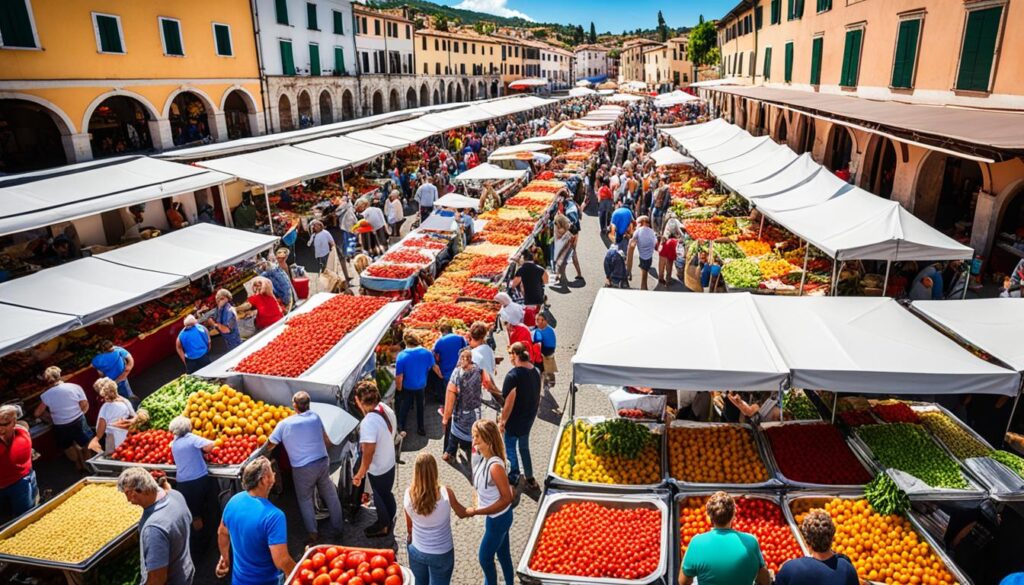
| Restaurant | Cuisine | Location |
|---|---|---|
| Nuevo Leon | Mexican | Little Village |
| Kristoffer’s Café & Bakery | Bakery | Pilsen |
| 5 Rabanitos | Mexican | Pilsen |
| Carnitas Uruapan | Mexican | Pilsen |
| Nellie’s Restaurant | Puerto Rican | Humboldt Park |
Letino Festivals and Events
Letino comes alive with excitement throughout the year, hosting a vibrant array of festivals and events that showcase the rich cultural heritage of the village. These celebrations provide visitors with a unique opportunity to immerse themselves in the local traditions and create lasting memories.
One of the most anticipated events in Letino is the Feast of San Nicola, held in December. This festivity pays homage to the village’s patron saint and is a true spectacle of music, dance, and food. The streets come alive with colorful processions, traditional costumes, and joyful melodies. It’s an unforgettable experience that truly embodies the spirit of Letino.
Another notable event in Letino is the Letino Summer Festival, which takes place during the warm summer months. This lively festival features a diverse range of performances, including local bands, dance troupes, and theater productions. Visitors can enjoy live music, dance the night away, and indulge in delicious street food.
Throughout the year, Letino also hosts various cultural and art exhibitions that highlight the talents of local artists. These exhibitions provide a glimpse into the vibrant arts scene of the village and allow visitors to appreciate the creativity and craftsmanship of the Letino community.
“Letino’s festivals and events are a true celebration of our community’s traditions, culture, and lively spirit. It’s a time when locals and visitors come together to create unforgettable memories and forge new connections.”
Letino festivals and events are not to be missed for anyone seeking an immersive cultural experience. From traditional music and dance to mouthwatering cuisine and captivating performances, these celebrations offer something for everyone. Plan your visit to Letino accordingly and make sure to mark these festive occasions on your itinerary.
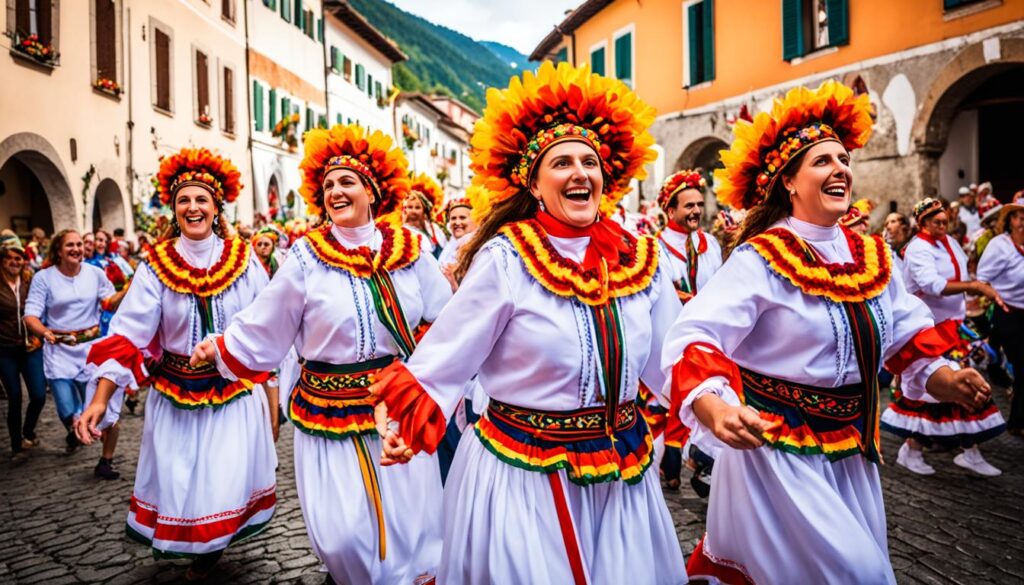
| Festival/Event | Date | Description |
|---|---|---|
| Feast of San Nicola | December | A celebration of Letino’s patron saint with processions, music, dance, and traditional food. |
| Letino Summer Festival | Throughout summer | A vibrant festival featuring live music, performances, and mouthwatering street food. |
| Cultural and Art Exhibitions | Year-round | Showcasing the artistic talents and cultural heritage of Letino through various exhibitions. |
Letino Natural Beauty
Letino is a haven for nature enthusiasts, surrounded by breathtaking natural beauty that captivates the senses and rejuvenates the soul. With its stunning landscapes and abundance of outdoor activities, Letino is a paradise for those seeking an adventure in the lap of nature.
One of the major highlights is the Matese Regional Park, a vast expanse of natural wonders waiting to be explored. This picturesque park offers a plethora of outdoor activities that cater to every adventurer’s preference. Whether you enjoy hiking, cycling, or horseback riding, the park’s well-maintained trails promise unforgettable experiences amidst nature’s wilderness.
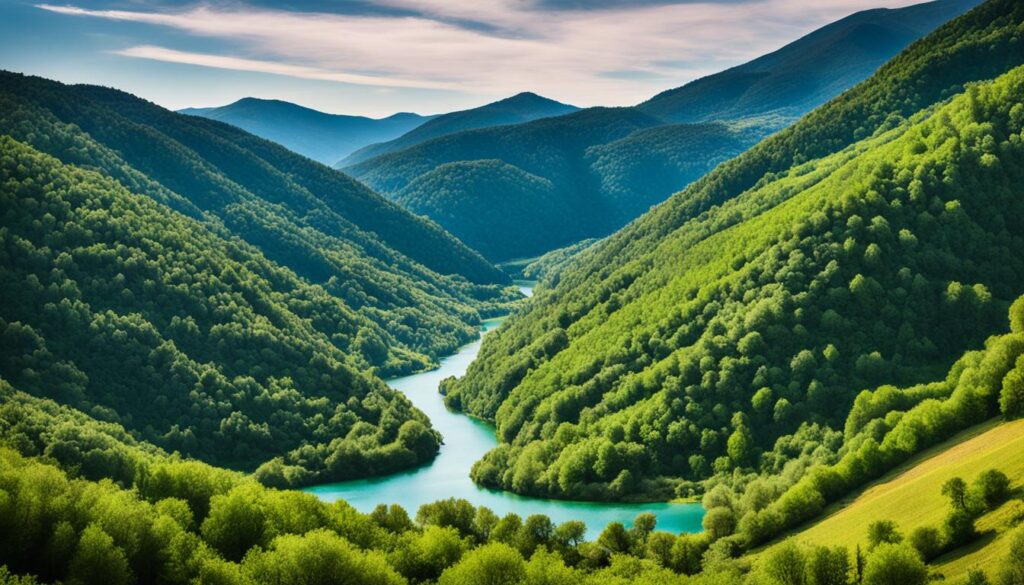
Step into a world of wonder as you traverse through lush forests, where sunlight filters through the canopy of trees, casting enchanting shadows on the forest floor. Immerse yourself in the tranquil ambiance of picturesque lakes, their pristine waters reflecting the awe-inspiring beauty that surrounds them. Be mesmerized by the majestic mountain views that stand tall against the horizon, inviting you to embrace the serenity of Letino’s natural landscapes.
Letino’s abundance of outdoor activities offers a chance to connect with nature, rejuvenate the body and mind, and create cherished memories. Whether you choose to embark on a thrilling hike through the Matese mountains, cycle through the scenic countryside, or explore the beauty of Letino’s landscapes on horseback, each adventure promises a unique and unforgettable experience.
Letino Natural Beauty:
| Activities | Description |
|---|---|
| Hiking | Explore the well-marked trails of the Matese Regional Park, taking you through ever-changing landscapes and rewarding you with breathtaking views. |
| Cycling | Ride through Letino’s countryside, immersing yourself in the scenic beauty and capturing the essence of the village’s natural landscapes. |
| Horseback Riding | Experience Letino’s beauty from a different perspective as you traverse its trails on horseback, surrounded by nature’s splendor. |
Letino’s natural beauty provides a serene and peaceful environment, allowing you to escape the hustle and bustle of everyday life. Whether you seek solace in the quiet tranquility of the forests, find inspiration in the vast expanses of lakes, or marvel at the grandeur of the mountains, Letino’s landscapes offer a perfect haven for reflection, relaxation, and outdoor adventures.
Letino Historical Sites
Letino is a village steeped in history, offering a treasure trove of historical sites to explore. Immerse yourself in the rich past of Letino as you visit these remarkable landmarks that stand as testaments to the village’s historical significance.
Church of San Nicola
One of Letino’s most iconic historical sites is the Church of San Nicola. This medieval church dates back to the 12th century and showcases beautiful architecture and exquisite frescoes that depict religious scenes. Step inside and be transported to a bygone era as you admire the intricate details and marvel at the craftsmanship of the past.
Medieval Buildings
As you wander through Letino’s narrow cobblestone streets, you’ll encounter an array of medieval buildings that serve as living remnants of the village’s historical roots. These architectural marvels display the charm and character of the past, capturing the essence of Letino’s rich heritage.
“Exploring Letino’s historical sites is like stepping back in time and experiencing the village’s fascinating past firsthand. The Church of San Nicola and the medieval buildings offer a glimpse into the lives of those who lived here centuries ago, leaving an indelible mark on Letino’s present.””
Letino’s Historical Sites: A Glimpse into the Past
| Historical Site | Description |
|---|---|
| Church of San Nicola | A medieval church with beautiful architecture and frescoes dating back to the 12th century. |
| Medieval Buildings | Wander through Letino’s narrow cobblestone streets and admire the medieval buildings that showcase the village’s historical roots. |
Discover Letino’s historical sites and embark on a journey through time. These landmarks offer a profound connection to the past and allow you to immerse yourself in Letino’s rich heritage.
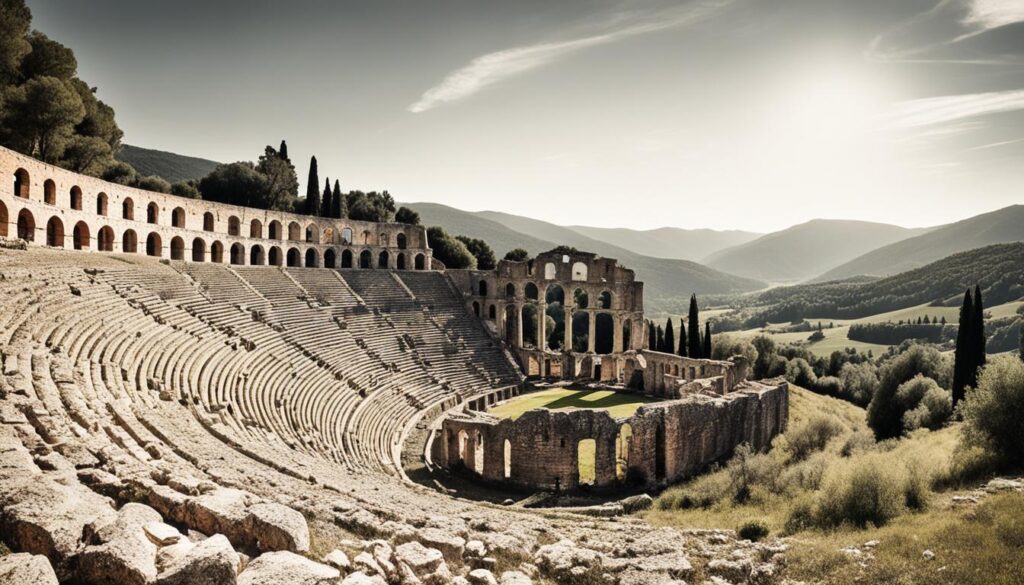
Letino Arts and Culture
Letino is a village that thrives in its vibrant arts and culture scene. Whether you’re a history enthusiast or an art lover, Letino has something to offer for everyone.
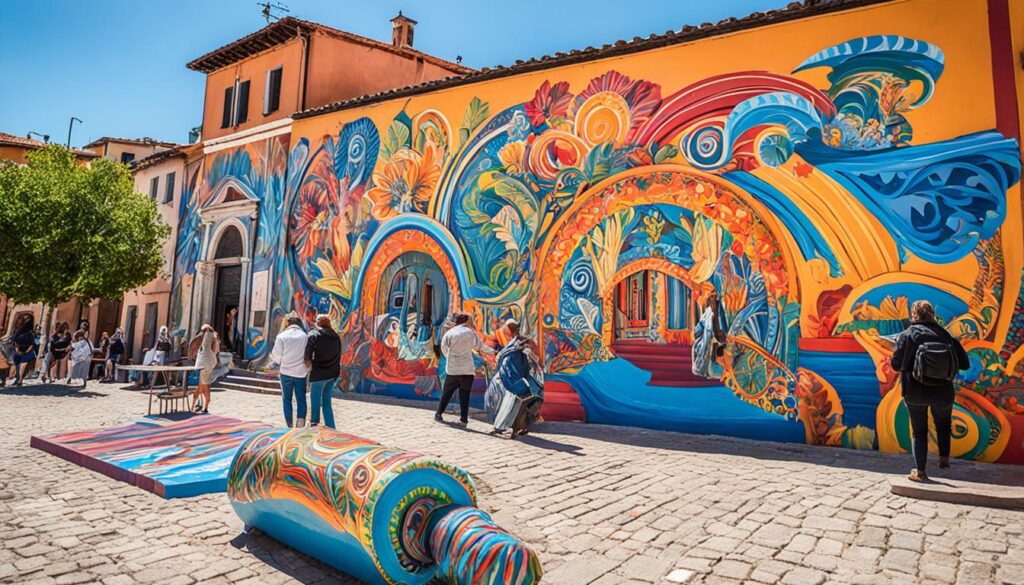
When it comes to exploring the local cultural heritage, the Letino Museum is a must-visit. Immerse yourself in the rich traditions of Letino as you discover traditional costumes, ancient tools, and fascinating artifacts. The museum provides a captivating glimpse into the village’s history.
The Letino Museum – Preserving Local Heritage
“The Letino Museum beautifully preserves our village’s cultural heritage, showcasing the stories of our ancestors through their cherished belongings and artistic creations. It’s a treasure trove of knowledge and a testament to our proud traditions.” – Local resident
Art lovers will appreciate the colorful street art that adorns the walls of Letino. Renowned artists have left their mark on the village, enhancing its charm with vibrant murals and installations. Take a leisurely stroll through the streets and marvel at the creativity and talent behind each artwork.
For an immersive experience in Mexican art and culture, the National Museum of Mexican Art awaits you in Letino. This museum showcases a diverse collection of Mexican artwork, including paintings, sculptures, and textiles. Explore the rich cultural heritage of Mexico and gain a deeper understanding of its artistic traditions.
Letino Museum – Traditional Costumes and Artifacts
The Letino Museum has carefully preserved traditional costumes, tools, and artifacts that tell the story of our village’s cultural heritage. From intricately embroidered garments to ancient farming tools, each display offers a fascinating glimpse into the daily lives of our ancestors.
| Exhibit | Description |
|---|---|
| Traditional Costumes | Discover the vibrant colors and intricate designs of Letino’s traditional costumes. Learn about the significance of each garment and the craftsmanship behind them. |
| Ancient Tools | Explore the tools used by our ancestors for farming and everyday tasks. From handcrafted plows to vintage kitchen utensils, these artifacts shed light on Letino’s rural traditions. |
| Artistic Creations | Admire the artistic creations of Letino’s talented craftsmen. From intricate woodwork to delicate ceramics, these pieces showcase the artistic prowess of our village. |
Letino’s arts and culture scene is a testament to the village’s rich heritage and the creative spirit of its residents. Immerse yourself in the world of Letino’s art, explore the local museum, and appreciate the captivating street art that brings a touch of color to our quaint streets.
Next, let’s delve into Letino’s accommodations, where you can enjoy a comfortable stay and soak in the village’s charm and hospitality.
Letino Accommodations
When visiting Letino, you’ll find a wide range of accommodations to suit your preferences. Whether you’re seeking a cozy stay in the heart of the village or breathtaking views of the surrounding landscapes, Letino has something for everyone.
If you want to immerse yourself in the charm of Letino’s historic center, we recommend staying in one of the local hotels or guesthouses. By choosing accommodations in this area, you’ll be within close proximity to the village’s shops, restaurants, and cultural attractions. It’s the perfect way to experience the authentic atmosphere and vibrant energy of Letino.
Alternatively, if you prefer a tranquil retreat surrounded by nature, consider booking a hotel in the countryside. The picturesque landscapes of Letino offer stunning views and a peaceful ambiance. Imagine waking up to breathtaking vistas of rolling hills and lush greenery before venturing out to explore the beauty of the Campania region.
Letino’s accommodations are designed to cater to your needs, ensuring a comfortable and enjoyable stay. From boutique hotels to charming bed and breakfasts, you’ll find a variety of options that suit different budgets and preferences. Whether you’re traveling solo, as a couple, or with family and friends, Letino’s accommodations are ready to welcome you.

Letino Transportation
Getting around Letino is a breeze with a variety of transportation options available to visitors. Whether you prefer public transportation, driving, or exploring on foot, Letino has you covered.
Public Transportation
If you’re looking for an easy way to travel to and from Letino, consider using public transportation. Buses and trains provide convenient and affordable options for getting around the region. They offer a chance to sit back, relax, and enjoy the scenic views as you journey to your desired destinations.
Car Rentals
For those who prefer the freedom and flexibility of having their own vehicle, car rentals are readily available in Letino. Renting a car allows you to explore the surrounding areas at your own pace and discover hidden gems off the beaten path. It’s a great option for travelers who want to venture beyond Letino and explore the wider Campania region.
Walking
Letino is a small village with narrow streets that are best explored on foot. Walking is not only a convenient way to get around but also a delightful experience that allows you to fully immerse yourself in the village’s charm. Stroll through the cobblestone streets, soak in the atmosphere, and discover the hidden treasures that Letino has to offer.

Whether you choose to rely on public transportation, rent a car, or take leisurely walks, Letino provides a seamless and enjoyable travel experience. With various transportation options at your disposal, you’ll have the freedom to explore the village and its surroundings with ease.
Letino Travel Tips
Planning a trip to Letino? Here are some travel tips to make your visit smooth and memorable:
- Best Time to Visit: The ideal time to explore Letino is during the spring or fall when the weather is mild and pleasant, making it perfect for outdoor activities and sightseeing.
- Avoid Summer Crowds: As Letino is an enchanting destination, it tends to attract more tourists during the summer months. To avoid large crowds and enjoy a more tranquil experience, plan your visit outside the peak season.
- Standard Travel Precautions: While Letino is generally considered safe, it’s always essential to take standard travel precautions. Keep your belongings secure, be aware of your surroundings, and follow any local guidelines or advisories.
- Learn Basic Italian Phrases: Enhance your cultural experience in Letino by learning a few basic Italian phrases. The locals will appreciate your effort, and it can make communication easier when dining out, shopping, or interacting with locals.
Now that you’re equipped with these travel tips, you’re ready to embark on a wonderful journey to Letino, immersing yourself in its vibrant culture and capturing unforgettable memories.
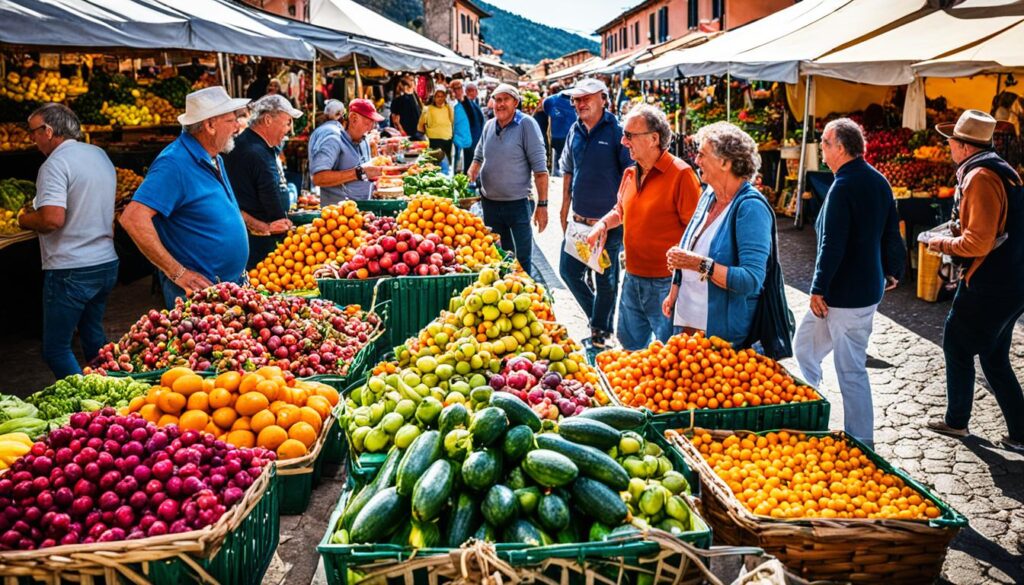
Letino Travel Checklist
Before you travel to Letino, make sure you have the essentials in place. Use this checklist to ensure a hassle-free trip:
| Travel Essentials | Checked |
|---|---|
| Valid Passport | ☑️ |
| Travel Insurance | ☑️ |
| Local Currency (Euros) | ☑️ |
| Adaptor for Electrical Outlets | ☑️ |
| Comfortable Walking Shoes | ☑️ |
| Medications and First Aid Kit | ☑️ |
| Guidebook or Maps | ☑️ |
| Phone Charger and Power Bank | ☑️ |
Letino Must-See Attractions
If you’re visiting Letino, make sure to explore these must-see attractions that showcase the village’s heritage and charm. From stunning architecture to captivating natural beauty, Letino has something for everyone.
1. Church of San Nicola
Don’t miss the opportunity to visit the Church of San Nicola, a true architectural gem in Letino. Marvel at its beautiful Gothic-style architecture and be captivated by the intricate frescoes that adorn its interior. The church, dating back to the 12th century, is a symbol of Letino’s rich history and religious traditions.
2. Matese Regional Park
Immerse yourself in the breathtaking natural beauty of Letino by exploring the Matese Regional Park. With its lush forests, picturesque lakes, and stunning mountain views, the park offers a tranquil escape from the hustle and bustle of daily life. Hike through its scenic trails, go cycling, or simply take in the serenity of nature.
3. Letino Museum
To truly experience the local culture and heritage, a visit to the Letino Museum is a must. Discover fascinating artifacts, traditional costumes, and historical tools that shed light on Letino’s rich cultural past. The museum offers a deeper understanding of the village’s traditions and customs, allowing you to immerse yourself in its vibrant history.
4. Vibrant Arts and Street Art
Letino’s arts and street art scene adds a vibrant touch to the village’s charm. Explore the colorful street art created by talented local artists, adding an extra layer of visual appeal to the already picturesque streets. Letino embraces artistic expression and creativity, making it a must-visit destination for art enthusiasts.
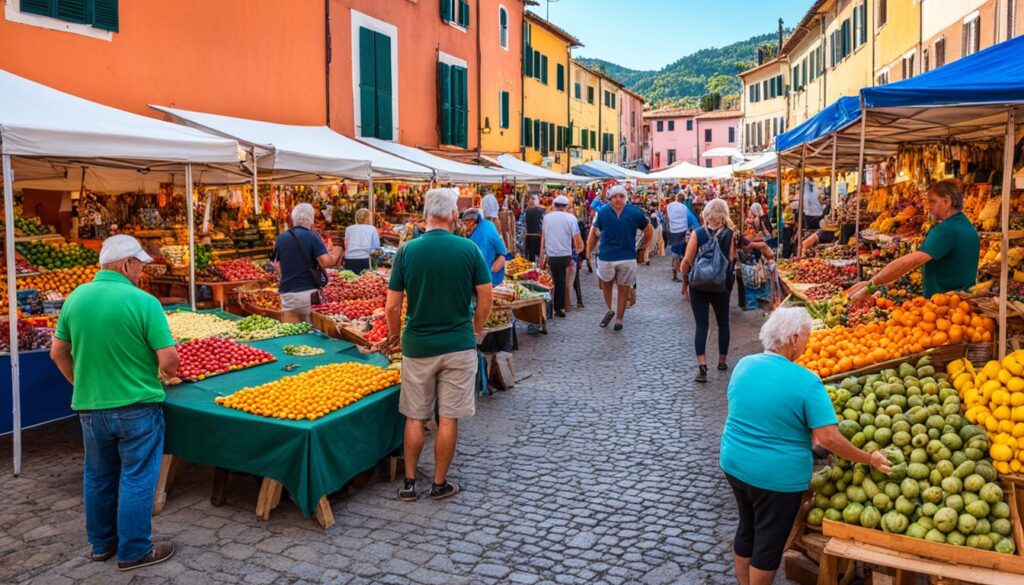
These must-see attractions in Letino offer a blend of historical, natural, and cultural experiences. From architectural marvels to captivating natural landscapes and artistic expressions, Letino has a lot to offer. Make sure to add these highlights to your itinerary for an unforgettable visit to this charming Italian village.
Letino Travel Videos
Immerse yourself in the beauty of Letino through authentic travel videos that provide inspiration and valuable tips for your upcoming trip. These videos offer a visual guide to help you discover enchanting sights, learn about the best places to visit, and gain insights into Letino’s vibrant culture.
By watching Letino travel videos, you can get a taste of what awaits you in this charming Italian village. From exploring historic landmarks to indulging in local cuisine, these videos showcase the diverse experiences available in Letino.
Whether you’re seeking adventure in Letino’s natural landscapes or looking to immerse yourself in its rich heritage, these videos provide a glimpse into the magical charm of this hidden gem. Letino travel videos offer practical tips, insider information, and captivating visuals that will enhance your trip planning process.
Get Inspired by Letino’s Enchanting Sights
“Letino’s cobblestone streets lined with medieval buildings transport you to another era, creating a truly picturesque and romantic setting.”
Explore Letino’s hidden corners and discover its narrow cobblestone streets, adorned with medieval architecture that tells tales of the village’s rich history. Letino travel videos capture the essence of this captivating place, showcasing its unique charm and captivating beauty.
Learn about the Best Places to Visit in Letino
“Letino’s Church of San Nicola is a must-visit for its stunning architecture, intricate frescoes, and historical significance.”
Discover the top attractions in Letino through informative travel videos that highlight the must-visit places. From the awe-inspiring Church of San Nicola to the breathtaking views of the Matese Regional Park, these videos provide valuable insights to help you plan your itinerary and make the most of your visit.
Experience Letino’s Vibrant Culture
“Letino’s festivals and cultural events are a true celebration of its rich heritage, filled with music, dance, and traditional cuisine.”
Dive into Letino’s vibrant culture by watching videos that capture the essence of its festivals and cultural events. You’ll get a taste of traditional music, colorful costumes, and mouthwatering local delicacies. Letino travel videos offer a glimpse into the lively spirit that permeates the village, making your trip even more enriching and memorable.
Letino travel videos provide inspiration, practical tips, and a visual guide to help you plan your trip. Whether you’re seeking adventure, cultural immersion, or simply want to explore the village’s natural beauty, these videos will ignite your wanderlust and ensure an unforgettable Letino experience.

Letino Trip Planning
Planning your trip to Letino is made easy with our trusted partners, offering great rates and a hassle-free booking experience. Ensure a smooth and enjoyable journey by booking your hotels, tours and activities, flights, and car rentals in advance to secure the best deals. Letino provides a range of options to make your trip planning convenient and stress-free.
Hotels
Letino offers a variety of accommodations to suit every traveler’s needs. Whether you prefer a cozy bed and breakfast in the heart of the village or a luxurious hotel with stunning views of the surrounding landscapes, there are options to cater to different preferences. Book your stay in Letino and experience the warm hospitality of this charming Italian village.
Tours and Activities
Immerse yourself in the rich culture and natural beauty of Letino with the help of local tours and activities. Explore the historical sites, embark on hiking adventures in the Matese Regional Park, or indulge in culinary experiences that showcase the best of Letino’s local cuisine. Letino offers a range of tours and activities that will enhance your trip and create lasting memories.
Flights
When planning your trip to Letino, consider the nearest airports and flight options available. Naples International Airport is the closest major airport, with domestic and international flights connecting to various destinations. Check for the best flight deals and secure your tickets to embark on your Letino adventure.
Car Rentals
Having a car during your stay in Letino allows you to explore the surrounding areas at your own pace. Renting a car gives you the freedom to visit nearby attractions, venture into the beautiful countryside, and fully experience the charm of Letino and its surroundings. Book your car rental in advance to ensure a seamless travel experience.
With Letino’s travel resources, you can easily plan and customize your trip, making it a memorable and fulfilling experience. Let our trusted partners assist you in creating your dream Letino itinerary.
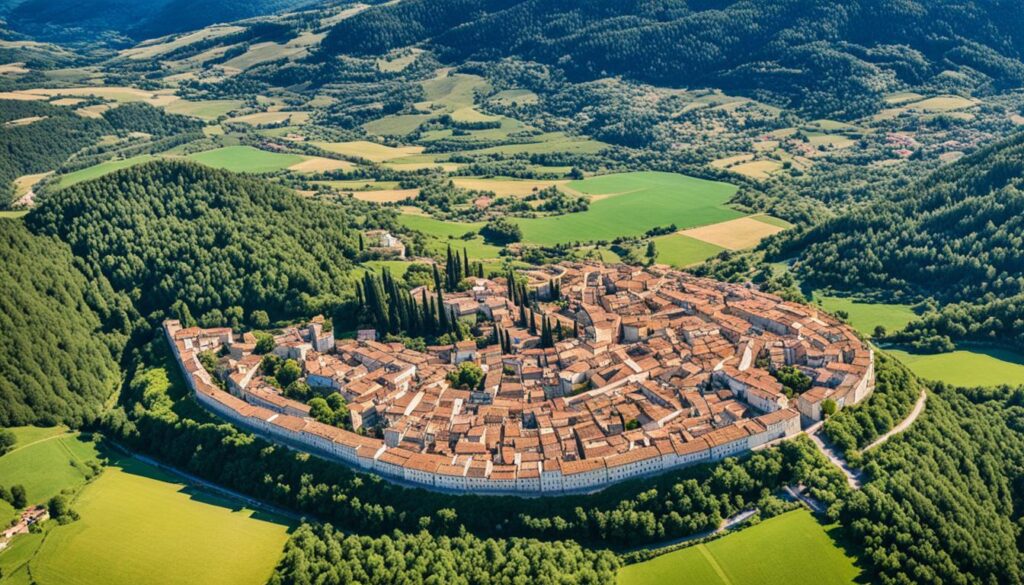
“Plan your trip to Letino with ease using trusted partners for great rates and a hassle-free booking experience.”
Conclusion
Letino, nestled in the heart of the Campania region of Italy, offers a truly enchanting experience that combines vibrant culture, rich history, and breathtaking natural beauty. Whether you’re exploring its historical sites, indulging in local cuisine, immersing yourself in the arts, or joining the lively festivals, Letino has something for everyone.
Discover the charm of this hidden gem by strolling through its narrow cobblestone streets and marveling at the medieval architecture. Take in the stunning frescoes of the Church of San Nicola or venture into the picturesque landscapes of the Matese Regional Park.
Letino’s authentic Italian cuisine will tantalize your taste buds, while the vibrant arts and cultural scene will impress and inspire you. Plan your trip to Letino and experience the enchanting beauty and cultural richness of this captivating Italian village.
FAQ
What is Letino?
Letino is a charming village located in the heart of the Campania region in Italy. It offers an authentic Italian experience with picturesque landscapes, rich history, and warm hospitality.
What are some things to do in Letino?
There are plenty of activities to immerse yourself in the local culture and experience the natural beauty of Letino. You can visit the Church of San Nicola, explore the Matese Regional Park, and visit the Letino Museum to learn about the village’s cultural heritage.
What is the cuisine like in Letino?
Letino is known for its delicious local cuisine. Visitors can taste authentic Mexican cuisine in Little Village, try the famous tres leches cake in Pilsen, and savor Puerto Rican flavors in Humboldt Park.
Are there any festivals and events in Letino?
Yes, Letino hosts various festivals and events throughout the year. One popular event is the Feast of San Nicola, held in December, where visitors can enjoy traditional music, dance, and food.
What are some natural attractions in Letino?
Letino is surrounded by breathtaking natural beauty. The Matese Regional Park offers hiking trails, lush forests, and picturesque lakes, providing opportunities for outdoor activities like hiking, cycling, and horseback riding.
Are there any historical sites in Letino?
Letino has a rich history and offers several historical sites to explore. The Church of San Nicola is a medieval church with stunning architecture and frescoes dating back to the 12th century. The village also showcases its historical roots through its medieval buildings and narrow cobblestone streets.
What is the arts and culture scene like in Letino?
Letino has a vibrant arts and culture scene. Visitors can visit the Letino Museum to discover the local cultural heritage and explore colorful street art created by renowned artists. Letino is also home to the National Museum of Mexican Art, which showcases Mexican art and culture.
What are the accommodation options in Letino?
Letino offers a variety of accommodations for visitors. You can choose to stay in the historic center for convenience to local shops and restaurants or opt for a hotel in the countryside for stunning views of the surrounding landscapes.
How to get around Letino?
Getting around Letino is easy with various transportation options. Public transportation like buses and trains are available, or you can choose to rent a car. Walking is also a great option for exploring the narrow streets of Letino.
What are some travel tips for visiting Letino?
The best time to visit Letino is during the spring or fall when the weather is mild and pleasant. It’s recommended to avoid the summer months when there are more crowds. Letino is a safe destination, but it’s always essential to take standard travel precautions. Learning a few basic Italian phrases can also enhance your cultural experience.
What are some must-see attractions in Letino?
Don’t miss the Church of San Nicola, the Matese Regional Park, and the Letino Museum. These attractions offer a true taste of Letino’s heritage and charm.
Where can I find travel videos about Letino?
You can find authentic travel videos about Letino for inspiration and practical tips. These videos provide a visual guide to help you plan your trip and make the most of your experience in Letino.
How can I plan my trip to Letino?
You can plan your Letino trip with ease using trusted partners for great rates and a hassle-free booking experience. Book your hotels, tours and activities, flights, and car rentals in advance to secure the best deals.
What is Letino’s cultural richness?
Letino is a hidden gem in the Campania region of Italy, offering a vibrant culture, rich history, and breathtaking natural beauty. From exploring historical sites and indulging in local cuisine to immersing in the arts and experiencing lively festivals, Letino has something for everyone.
In the vast and diverse world of coffee, coffee alternatives, and tea, Olivia has found her calling. As an author and a dedicated coffee and tea aficionado, her work for Cappuccino Oracle reflects her profound love and understanding of the intricate complexities found within these beverages. Olivia’s passion for the subject serves as both a catalyst for her creativity and a connection point with her audience.
Olivia’s appreciation for coffee, coffee alternatives, and tea blossomed at an early age. She discovered that these beverages invigorated her senses and stimulated her creative spirit. From the nuanced flavors of single-origin roasts to the captivating narratives intertwined with coffee, coffee alternatives, and tea trade and culture, Olivia found an unlimited source of inspiration in her daily cup.
Her love for these beverages and her talent for storytelling eventually converged at Cappuccino Oracle. As an author, Olivia’s mission is to illuminate the intricate tapestry that makes up the world of coffee, coffee alternatives, and tea. Her articles span a diverse range of topics, encompassing everything from the unique flavors of different brews to the sociocultural history intertwined with their cultivation and consumption.
Coffee Culture Around the World
Ethiopian Coffee: From Bean to Brew History & Culture

Did you know that Ethiopia is widely recognized as the birthplace of coffee? With a history dating back over 1,000 years, Ethiopian coffee has become an integral part of the country’s culture and daily life. From the mesmerizing coffee ceremonies to the diverse flavors and unique processing methods, Ethiopian coffee offers a fascinating journey from bean to brew.
Key Takeaways:
- Ethiopia is the birthplace of coffee, with a history spanning over 1,000 years.
- The traditional Ethiopian coffee ceremony is a significant part of Ethiopian culture.
- Ethiopian coffee beans come in a variety of heirloom varietals with distinct flavor profiles.
- Elevation plays a role in the flavor of Ethiopian coffee, with higher altitudes resulting in more complex flavors.
- Ethiopia has various coffee processing methods, including the wet, dry, natural, and honey process.
The History of Coffee in Ethiopia
According to legend, coffee was first discovered in Ethiopia over 1,000 years ago by a goatherd named Kaldi. Kaldi noticed that his goats became more energetic after eating the bright red berries of a particular tree. Intrigued, Kaldi tried the berries himself and experienced a similar boost in energy. The story of Kaldi and his energetic goats quickly spread, and coffee began to spread throughout the region. By the 15th century, coffee was being grown and exported from Ethiopia to Yemen, and from there it spread to the rest of the world.
Today, Ethiopia is still home to some of the oldest and most revered coffee trees in the world.

Legend has it that the discovery of coffee in Ethiopia can be traced back to a curious goatherd named Kaldi. As the story goes, Kaldi noticed his goats became unexpectedly lively and restless after consuming the bright red berries from a particular tree. Intrigued by this phenomenon, Kaldi decided to try the berries himself.
To his delight, Kaldi experienced a surge of energy and alertness. Word of Kaldi’s discovery quickly spread and caught the attention of monks in nearby monasteries. They began experimenting with the berries, leading to the development of various techniques to roast, grind, and brew them.
“The story of Kaldi and his energetic goats quickly spread, and coffee began to spread throughout the region.”
By the 15th century, coffee cultivation had expanded from Ethiopia to Yemen, where it became a beloved beverage. From there, coffee made its way to the rest of the world through trade and exploration, forever changing the global coffee culture.
Today, Ethiopia remains a significant player in the coffee industry, known for its high-quality beans and rich coffee heritage.
Bean Varietals and Flavor Characteristics
Ethiopia is renowned for its diverse selection of coffee bean varietals, which includes the highly prized heirloom varieties. These heirloom varietals are cherished for their distinct flavor profiles, offering a complex and nuanced taste experience with delightful notes of fruit, flowers, and spices.
When it comes to Ethiopian coffee, flavor characteristics tend to vary based on the region where it is grown. Each unique microclimate and soil condition found in different regions influences the final flavor of the coffee beans.
Notable Ethiopian coffee-growing regions such as Yirgacheffe, Sidamo, and Harar offer their own distinctive flavor profiles.
Yirgacheffe
The Yirgacheffe region is known for its light and floral flavors, often accompanied by delightful notes of citrus and stone fruit. The coffee beans grown here produce a vibrant and refreshing cup with a delicate and aromatic profile.
Sidamo
Sidamo, on the other hand, is celebrated for its full-bodied and sweet flavors. With hints of chocolate and berries, the coffee beans from Sidamo create a rich and satisfying brew, bringing together the best of sweetness and complexity.
Harar
Harar is famous for its bold and earthy flavors, combining exotic spices and fruity undertones. The coffee beans grown in this region provide a truly unique and distinctive flavor experience that is loved by coffee enthusiasts worldwide.
These regional flavor profiles, along with the diverse range of heirloom varietals, make Ethiopian coffee a delightful choice for those seeking adventurous and flavorful brews.

How Elevation Affects Coffee Flavor
In the diverse landscapes of Ethiopia, elevation plays a significant role in shaping the flavor of coffee. The altitude at which coffee is grown influences its taste profile, making high altitude coffee a true delight for coffee enthusiasts.
Coffee grown at higher elevations, typically above 1,500 meters (4,921 feet) above sea level, benefits from the unique environmental conditions present in these regions. The cooler temperatures and thinner air at higher elevations slow down the maturation process of coffee cherries. This extended maturation period allows for more complex flavors to develop within the beans.
“The cooler temperatures at higher altitudes result in slower maturation rates for the coffee cherries, contributing to the development of complex flavors.”
“High altitude coffee is like a symphony of flavors dancing on your palate.”
High altitude coffee often exhibits a wide range of flavor characteristics, including fruity and floral notes, as well as nuanced hints of spices and berries. These complex flavors can add depth and a delightful complexity to your coffee drinking experience.
On the other hand, coffee grown at lower elevations, between 600 to 1,200 meters (1,968 to 3,937 feet) above sea level, tends to have a more straightforward, classic coffee flavor profile. The faster maturation rates and warmer temperatures at lower altitudes result in a simpler taste profile, characterized by bolder and less nuanced flavors.

| Elevation | Flavor Profile |
|---|---|
| High | Complex, nuanced, vibrant |
| Low | Bold, straightforward, classic |
By considering the elevation at which coffee is grown, coffee enthusiasts can choose beans that align with their preferred flavor profiles. Whether you enjoy the vibrant complexity of high altitude coffee or the bold simplicity of lower elevation beans, Ethiopian coffee offers a delightful range of flavors to suit every taste.
Common Coffee Processing Methods in Ethiopia
Ethiopia is renowned for its diverse coffee processing methods, each contributing to the unique flavors and characteristics of Ethiopian coffee. The country employs various techniques, including the wet process, dry process, natural process, and honey process.
The Wet Process:
A delicate and meticulous method, the wet process involves removing the outer layers of the coffee cherry using water. This process helps bring out the coffee’s delicate flavors and acidity, resulting in a bright and clean cup of coffee.
The Dry Process:
The dry process, also known as the natural process, is a traditional method where coffee cherries are laid out in the sun to dry. The cherries are then removed, revealing the beans. This process imparts bold and fruity flavors, with notes of berries and a rich body.
The Natural Process:
The natural process involves drying the coffee cherries with the outer layers still intact. This prolonged exposure to the fruit imparts a distinct fruity and wine-like flavor profile to the beans. Natural process coffees often exhibit intense flavors with a sweet aftertaste.
The Honey Process:
Unique to Ethiopia, the honey process is a hybrid method that combines aspects of both the wet and dry processes. During this process, a layer of sticky mucilage is left on the beans as they dry, creating a smooth and sweet cup of coffee with a subtle honey-like aroma and flavor.

| Processing Method | Description | Flavor Profile |
|---|---|---|
| Wet Process | Outer layers of the coffee cherry are removed using water. | Delicate flavors, bright acidity. |
| Dry Process (Natural Process) | Coffee cherries are dried in the sun before the beans are removed. | Bold, fruity flavors with notes of berries and rich body. |
| Natural Process | Coffee cherries are dried with the outer layers intact. | Fruity and wine-like flavors, intense and sweet. |
| Honey Process | Beans are dried with a layer of mucilage for a smooth and sweet flavor. | Smooth, sweet flavors with a subtle honey-like aroma. |
The various processing methods used in Ethiopian coffee production contribute to the diversity of flavor profiles found in Ethiopian coffee. Whether you prefer the delicate nuances of the wet process, the bold and fruity flavors of the dry process, the intense complexity of the natural process, or the smooth sweetness of the honey process, Ethiopian coffee offers a captivating range of taste experiences.
Ethiopian Coffee in Culture and Daily Life
Coffee holds a central role in Ethiopian culture and daily life, shaping the country’s traditions and fostering social connections. The traditional Ethiopian coffee ceremony, known as espresso coffee in Amharic, is a vibrant and cherished social gathering that brings people together to celebrate the art of coffee preparation and sharing.
The Ethiopian coffee ceremony is an intricate process that involves roasting, grinding, and brewing coffee in a specially-designed pot called a jebena. The ceremony begins with the ceremonial washing of the coffee beans, followed by roasting them in a pan over an open fire. The aroma of the roasting coffee fills the air, creating an enchanting atmosphere.
After the beans are ground to a fine consistency using a traditional mortar and pestle, they are carefully poured into the jebena along with water. The jebena is heated on a small charcoal stove and allowed to brew slowly, infusing the water with the rich flavors and aromas of the coffee.
Once the coffee is ready, it is served in small cups known as si’ni. The host or hostess takes great care in pouring the coffee with graceful movements, maintaining a steady flow from a height to produce a distinctive foam known as meskela. The ceremony also includes the ritualistic offering of coffee to guests as a symbol of friendship and hospitality.
“Coffee is our bread, and we say ‘Drink coffee’ when we mean ‘Let’s have a conversation.'”
The Ethiopian coffee ceremony is much more than a simple act of brewing and consuming coffee; it is a celebration of community, friendship, and cultural identity. It serves as a platform for engaging in meaningful conversations, fostering connections, and strengthening social bonds.
Within the rich tapestry of Ethiopian language and expressions, coffee is deeply ingrained. Phrases like “Coffee is our bread” and “Drink coffee” are commonly used to express the importance of socializing and connecting with others over a cup of coffee. These phrases reflect the cultural significance of coffee as a source of sustenance and a catalyst for social interaction.
Today, Ethiopian coffee ceremonies can still be experienced in many villages and cities throughout the country, offering visitors a unique opportunity to immerse themselves in the rich coffee culture of Ethiopia. Witnessing the meticulous preparation, the graceful pouring, and the camaraderie that unfolds during the ceremony provides a glimpse into the heart of Ethiopian hospitality and tradition.

Immerse yourself in the captivating Ethiopian coffee culture and experience the warmth, flavors, and community that coffee brings. Join in the age-old tradition of the Ethiopian coffee ceremony and allow yourself to be transported to a world where coffee is more than just a beverage—it is a symbol of connection, unity, and the vibrant spirit of a nation.
Ethiopian Coffee Growing Regions
Ethiopia, often referred to as the birthplace of coffee, is known for its diverse coffee growing regions that produce beans with distinct flavors. The three central coffee growing regions in Ethiopia are Sidamo, Yirgacheffe, and Harrar. Each region has its own unique characteristics that contribute to the wide range of flavors found in Ethiopian coffee.
Sidamo
Sidamo is renowned for its full-bodied coffee with sweet, floral notes and hints of chocolate and berries. The coffee beans grown in this region are meticulously cultivated at elevations ranging from 1,500 to 2,200 meters, resulting in a vibrant and complex flavor profile. Sidamo coffee is highly sought after for its sweetness and balanced acidity.
Yirgacheffe
Yirgacheffe, nestled in the Sidamo region, is celebrated for its light-bodied coffee with delicate floral flavors and pronounced citrus and stone fruit undertones. The coffee beans from this region thrive in the fertile soil and higher altitudes of 1,700 to 2,200 meters above sea level, lending a distinctive brightness and acidity to the brew. Yirgacheffe coffee is often revered for its exceptional clarity and complexity of flavors.
Harrar
Harrar, located in the Eastern Highlands of Ethiopia, produces coffee with bold and robust flavors. The coffee beans of Harrar exhibit a unique combination of earthy notes, hints of spice, and fruity undertones. Grown at elevations ranging from 1,400 to 2,000 meters, the beans develop a distinctively strong character. Harrar coffee is beloved for its rich complexity and satisfying intensity.
The diversity of Ethiopian coffee regions, including Sidamo, Yirgacheffe, and Harrar, provides coffee enthusiasts with a wide range of flavor options to explore and savor. These regions showcase the country’s dedication to producing high-quality coffee with distinct taste profiles that reflect the unique terroir of each area.
| Region | Flavor Profile | Elevation (meters) |
|---|---|---|
| Sidamo | Full-bodied with sweet, floral notes; hints of chocolate and berries | 1,500 – 2,200 |
| Yirgacheffe | Light-bodied with delicate floral flavors; notes of citrus and stone fruit | 1,700 – 2,200 |
| Harrar | Bold and robust with earthy notes; hints of spice and fruit | 1,400 – 2,000 |

The Rise of Ethiopian Coffee Culture
The cultivation of coffee in Ethiopia began in the 16th century, with coffee beans being harvested from wild coffee plants. Trade with neighboring countries, particularly Yemen, enabled Ethiopia to share its coffee with the rest of the world. By the 1800s, coffee production had become a major industry in Ethiopia, with cafes springing up in major cities.
Ethiopian coffee ceremonies became a regular part of daily life, providing a place for people to connect and enjoy a cup of coffee. Today, Ethiopia is one of the world’s leading coffee producers, known for its high-quality beans and unique flavor profiles.
Coffee Cultivation in Ethiopia
| Coffee Cultivation | Ethiopian Coffee Industry |
|---|---|
| Ethiopia’s coffee cultivation began in the 16th century | Ethiopia is one of the world’s leading coffee producers |
| Wild coffee plants were initially harvested | Ethiopian coffee is known for its high quality |
| Trade with Yemen helped spread Ethiopian coffee worldwide | Ethiopia cultivates unique flavor profiles |
| Coffee production became a major industry by the 1800s | Cafes emerged in major Ethiopian cities |
“Ethiopian coffee is known for its distinctive flavors and rich cultural heritage.” – Ethiopian Coffee Association
Through centuries of cultivation and trade, Ethiopian coffee has risen to prominence. Today, it is revered for its high quality and unique flavor profiles. The Ethiopian coffee industry continues to thrive, with a rich coffee culture ingrained in the daily lives of Ethiopians.

The Legends of Ethiopian Coffee Discovery
Ethiopian coffee has a long and fascinating history, intertwined with legends that have been passed down through generations. These stories capture the essence of coffee’s significance in Ethiopian culture and its place as a beloved beverage. Two notable legends stand out in the tales of Ethiopian coffee discovery – the legend of Kaldi and the legend of Sheikh Omar.
The Legend of Kaldi
According to the popular legend of Kaldi, a goatherd in Ethiopia named Kaldi discovered the energizing properties of coffee by chance. While tending to his goats, Kaldi noticed that they became more lively and energetic after eating the bright red berries of a certain tree. Intrigued, he decided to try the berries himself and experienced a similar surge of energy. Excited by his discovery, Kaldi shared this newfound delight with others, and thus began the journey of Ethiopian coffee.
“Kaldi’s goats, filled with newfound energy, captured the attention of the locals, sparking curiosity and fascination.”
The Legend of Sheikh Omar
Another legend attributes the discovery of coffee to Sheikh Omar, a Muslim man living in Yemen during the ninth century. The story goes that Sheikh Omar was exiled to a desert cave where food was scarce. Desperate for sustenance, he started chewing on the leaves of nearby coffee plants. He found that their stimulating effects kept him alert and sustained during his exile. Recognizing the value of this discovery, Sheikh Omar shared his newfound knowledge upon returning to Ethiopia, elevating coffee to a cultural phenomenon.
“Sheikh Omar’s exile turned out to be a catalyst for the spread of coffee, as he introduced it to the people upon his return to Ethiopia.”
Both legends highlight the role of individuals in uncovering the magic of coffee and their contributions to its prominence in Ethiopian culture. Whether it was Kaldi’s goats or Sheikh Omar’s exile, these tales emphasize the serendipitous nature of coffee’s discovery and its subsequent assimilation into the fabric of Ethiopian life.
| Legend of Kaldi | Legend of Sheikh Omar |
|---|---|
| Discovered energizing properties of coffee by observing his goats | Recognized the stimulating effects of coffee leaves during exile |
| Shared the discovery, leading to the proliferation of coffee | Introduced coffee to the people upon returning to Ethiopia |
The Importance of Coffee in Ethiopian Language and Expressions
Coffee holds a profound significance in Ethiopian culture, so much so that it permeates the language and expressions of the Ethiopian people. Ethiopian coffee sayings, such as “Coffee is our bread” and “Drink coffee,” beautifully illustrate the central role that coffee plays as a source of sustenance and socialization.
The use of coffee-related expressions extends beyond the mere act of drinking coffee. These expressions often symbolize interpersonal relationships and social connections, emphasizing the deep-rooted presence of coffee in the daily lives and culture of Ethiopians. The richness and vibrancy of the coffee culture in Ethiopia can be experienced through the language itself.
“Coffee is our bread.”
This saying encapsulates the significance of coffee in Ethiopian life. It highlights coffee’s role as an essential staple, nourishing not only the body but also the spirit. Just as bread is a fundamental element of sustenance, coffee is integral to the lives and customs of Ethiopians.
“Drink coffee.”
While this phrase may seem self-explanatory, its true meaning goes much deeper. “Drink coffee” signifies more than just consuming the beverage; it embodies the act of coming together, sharing stories, and strengthening bonds. It encapsulates the social aspect of coffee and its ability to foster connections and build relationships.
In Ethiopian culture, coffee is not solely a beverage; it is a symbol of unity, hospitality, and tradition. Through coffee-related expressions, the importance of coffee in everyday life is beautifully conveyed, enhancing the cultural fabric of Ethiopia.
Sample Ethiopian Coffee Sayings:
- The aroma of coffee is the fragrance of freedom.
- Coffee awakens the soul as the sun awakens the day.
- A coffee shared is a problem halved.
- A well-brewed coffee is like a heartfelt poem.
- Good coffee is like a friend – dependable and comforting.
These sayings reflect the reverence and appreciation Ethiopians have for their beloved beverage. They serve as a testament to the enduring bond between coffee and the Ethiopian people, reminding us of the cultural significance that coffee holds in Ethiopia.

Conclusion
Ethiopian coffee is more than just a beverage; it is a symbol of culture and tradition. With a history dating back over a thousand years, Ethiopian coffee holds a special place in the hearts of coffee enthusiasts around the world. Its unique flavor profiles, derived from diverse bean varietals and the influence of elevation, make it a truly exceptional experience for every coffee lover.
One cannot talk about Ethiopian coffee without mentioning the traditional coffee ceremony. This ceremonial event brings people together, fostering connection and community as they gather to roast, grind, and brew coffee in the specially-designed jebena pot. It is a true celebration of Ethiopian culture and a testament to the country’s deep-rooted appreciation for the art of coffee production.
For those seeking exceptional flavors and a cultural experience like no other, Ethiopian coffee is a must-try. Whether you are a seasoned coffee connoisseur or simply enjoy a good cup of joe, be sure to explore the diverse flavors of Ethiopian coffee varietals like Sidamo, Yirgacheffe, and Harrar. Each region offers its own distinct taste that will transport you on a sensory journey through the coffee-growing landscapes of Ethiopia.
As the birthplace of coffee, Ethiopia continues to cultivate and share its treasured beverage with the world. The country’s dedication to the art and craft of coffee production is evident in every sip. So, whether you are sipping a cup at a local coffee shop or experiencing the traditional Ethiopian coffee ceremony, let the rich history and flavors of Ethiopian coffee captivate your senses and leave you craving for more.
FAQ
What is the history of coffee in Ethiopia?
According to legend, coffee was discovered in Ethiopia over 1,000 years ago by a goatherd named Kaldi. It spread from there, and by the 15th century, it was being exported to Yemen and the rest of the world.
What are the different coffee bean varietals in Ethiopia?
Ethiopia is known for its diverse array of coffee bean varietals, including the famous heirloom varieties. Each varietal has its own unique flavor profile, with notes of fruit, flowers, and spices.
How does elevation affect the flavor of Ethiopian coffee?
The altitude at which coffee is grown in Ethiopia has a significant impact on its flavor. Higher elevations result in more complex flavors, while lower elevations produce a simpler coffee flavor.
What are the common coffee processing methods used in Ethiopia?
Ethiopia employs several coffee processing methods, including the wet process, dry process, natural process, and honey process. Each method imparts distinct flavors to the coffee.
How does coffee play a role in Ethiopian culture and daily life?
Coffee is central to Ethiopian culture, and the traditional coffee ceremony is an important social gathering. It brings people together, promotes socialization, and is deeply ingrained in the language and expressions of Ethiopians.
What are the different coffee growing regions in Ethiopia?
Ethiopia has three central coffee growing regions: Sidamo, Yirgacheffe, and Harrar. Each region produces coffee with its own distinct flavor profile.
How did Ethiopian coffee cultivation evolve over time?
Coffee cultivation in Ethiopia began in the 16th century, and by the 1800s, it had become a major industry. Ethiopian coffee ceremonies became a regular part of daily life, and today Ethiopia is one of the world’s leading coffee producers.
What are the legends surrounding the discovery of coffee in Ethiopia?
There are several legends surrounding the discovery of coffee in Ethiopia, including one involving a goatherd named Kaldi and another featuring a Muslim man named Sheikh Omar. These legends reflect the deep history and cultural significance of coffee in Ethiopia.
How important is coffee in Ethiopian language and expressions?
Coffee holds such importance in Ethiopian culture that it is reflected in the language and expressions of the people. Phrases like “Coffee is our bread” and “Drink coffee” demonstrate its central role as a source of sustenance and socialization.
What makes Ethiopian coffee unique and culturally significant?
Ethiopian coffee has a rich history, diverse flavor profiles, and plays a central role in Ethiopian culture. It is a must-try for coffee connoisseurs and those who appreciate exceptional flavors with cultural significance.
Source Links
- https://creaturecoffee.co/blogs/creature-feature-a-specialty-coffee-blog/the-fascinating-history-and-culture-of-ethiopian-coffee
- https://www.thespruceeats.com/ethiopian-coffee-culture-765829
- https://www.caffeluxxe.com/blogs/news/story-of-ethiopian-coffee
In the vast and diverse world of coffee, coffee alternatives, and tea, Olivia has found her calling. As an author and a dedicated coffee and tea aficionado, her work for Cappuccino Oracle reflects her profound love and understanding of the intricate complexities found within these beverages. Olivia’s passion for the subject serves as both a catalyst for her creativity and a connection point with her audience.
Olivia’s appreciation for coffee, coffee alternatives, and tea blossomed at an early age. She discovered that these beverages invigorated her senses and stimulated her creative spirit. From the nuanced flavors of single-origin roasts to the captivating narratives intertwined with coffee, coffee alternatives, and tea trade and culture, Olivia found an unlimited source of inspiration in her daily cup.
Her love for these beverages and her talent for storytelling eventually converged at Cappuccino Oracle. As an author, Olivia’s mission is to illuminate the intricate tapestry that makes up the world of coffee, coffee alternatives, and tea. Her articles span a diverse range of topics, encompassing everything from the unique flavors of different brews to the sociocultural history intertwined with their cultivation and consumption.
Coffee Culture Around the World
Scopri Il Libro degli Ospiti di Capriati al Volturno
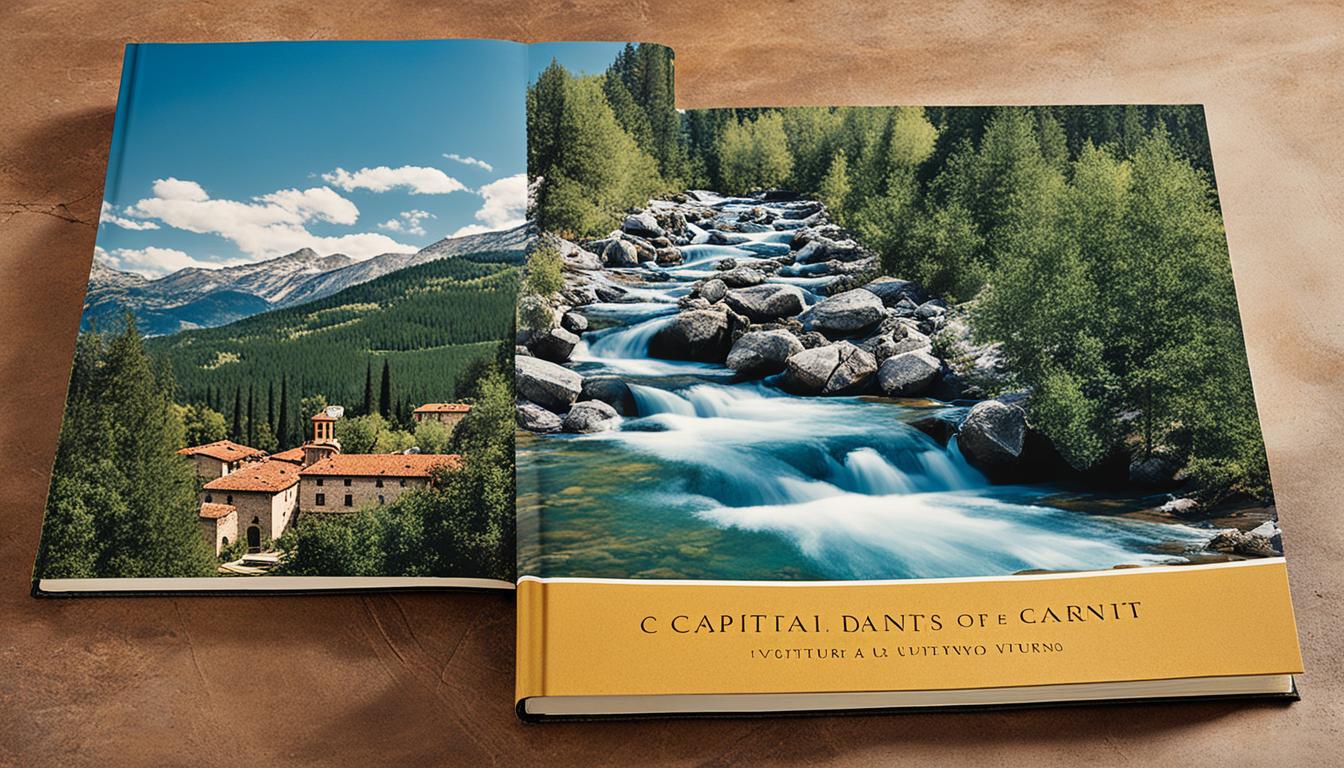
Sapevi che Capriati al Volturno custodisce uno straordinario patrimonio culturale? Ti presentiamo il Libro degli Ospiti di Capriati al Volturno, un’affascinante testimonianza della storia e dell’eredità di questo incantevole paese. Attraverso questo libro, potrai intraprendere un viaggio alla scoperta delle storie e delle esperienze che hanno plasmato Capriati al Volturno.
Key Takeaways:
- Capriati al Volturno custodisce un ricco patrimonio culturale messo in mostra nel Libro degli Ospiti.
- Esplora la storia e l’eredità di Capriati al Volturno attraverso questo straordinario libro.
La presentazione del Progetto STOP BULLYING
L’8 maggio 2018 si è svolto a Capriati al Volturno un convegno conclusivo per la presentazione del Progetto STOP BULLYING. Questo progetto ha coinvolto i ragazzi delle scuole locali ed è stato promosso per contrastare il fenomeno del bullismo e promuovere la prevenzione dei comportamenti devianti e dell’abbandono scolastico.
“La prevenzione è il primo passo per combattere il bullismo in tutte le sue forme. Il Progetto STOP BULLYING mira a sensibilizzare gli studenti, educarli sulle conseguenze negative del bullismo e fornire loro strumenti per combatterlo. È fondamentale creare un ambiente scolastico sicuro e rispettoso, in cui ciascun studente possa sentirsi supportato e valorizzato.”
I principali obiettivi del Progetto STOP BULLYING includono:
- Promuovere una cultura di rispetto, tolleranza e inclusione all’interno delle scuole
- Offrire formazione agli insegnanti e al personale scolastico per identificare e intervenire sui casi di bullismo
- Sensibilizzare gli studenti su come riconoscere situazioni di bullismo e come reagire in modo appropriato
- Fornire supporto emotivo e psicologico agli studenti vittime di bullismo
- Creare una rete di collaborazione tra le scuole, le famiglie e le istituzioni locali per affrontare il fenomeno del bullismo
Il Progetto STOP BULLYING si basa su una strategia multidisciplinare che coinvolge insegnanti, studenti, famiglie, psicologi ed esperti nel settore. Attraverso questa iniziativa, si spera di contribuire a creare un’atmosfera scolastica sicura e inclusiva, in cui ogni studente possa svilupparsi in modo armonioso e pieno potenziale.
| Benefici del Progetto STOP BULLYING | Statistiche a sostegno |
|---|---|
| Prevenzione del bullismo e dei comportamenti devianti | Il 70% degli studenti coinvolgono il fenomeno del bullismo viene a conoscenza delle situazioni di bullismo |
| Promozione di un’atmosfera scolastica sicura e inclusiva | Le scuole che implementano programmi anti-bullismo vedono una riduzione del 25% dei casi di bullismo |
| Miglioramento del rendimento scolastico degli studenti | Gli studenti coinvolti in iniziative di prevenzione del bullismo mostrano un aumento del 20% delle performance accademiche |
Il ruolo della scuola nella lotta al bullismo
Durante il nostro convegno, abbiamo sottolineato il ruolo fondamentale della scuola nel contrastare il bullismo e il cyber-bullismo.
La scuola è il primo luogo in cui gli alunni sperimentano le relazioni sociali, ed è quindi essenziale che essa riesca a leggere le dinamiche che sottendono a questi fenomeni e ad intervenire in modo adeguato per prevenirli.
La prevenzione del bullismo e del cyber-bullismo deve essere parte integrante del programma educativo delle scuole. È fondamentale che gli insegnanti siano formati per riconoscere segni di bullismo e offrire aiuto agli studenti coinvolti. Inoltre, è importante promuovere un clima di rispetto, inclusione e tolleranza all’interno dell’istituzione scolastica.
La scuola ha la responsabilità di creare un ambiente sicuro e accogliente in cui gli studenti possano esprimersi liberamente, senza paura di discriminazioni o violenze.
Attraverso la promozione di progetti di educazione civica, l’insegnamento dei valori di rispetto e empatia, nonché l’organizzazione di attività di sensibilizzazione sul bullismo, la scuola può svolgere un ruolo determinante nella prevenzione di questi comportamenti dannosi.
È importante coinvolgere anche i genitori e la comunità nell’affrontare il problema del bullismo, creando una rete di supporto e collaborazione che contribuisca a costruire un ambiente scolastico sano e inclusivo.

Strategie per la prevenzione del bullismo:
- Educazione ai valori di rispetto, inclusione e tolleranza
- Sensibilizzazione sulle conseguenze negative del bullismo
- Creazione di programmi di educazione civica
- Formazione degli insegnanti per riconoscere e affrontare il bullismo
- Implementazione di politiche e procedure anti-bullismo
- Collaborazione tra scuola, genitori e comunità
È fondamentale che ogni scuola si adoperi per creare un ambiente sicuro e inclusivo in cui gli studenti possano crescere e apprendere in modo sereno e rispettoso.
Risultati del coinvolgimento della scuola nella prevenzione del bullismo
| Benefici per gli studenti | Benefici per la scuola e la comunità |
|---|---|
| Gli studenti si sentono sicuri e protetti | Diminuzione dei casi di bullismo e cyber-bullismo |
| Minore rischio di abbandono scolastico | Crescita di un clima scolastico positivo |
| Miglioramento delle relazioni sociali | Consolidamento della reputazione della scuola |
| Aumento del rendimento accademico | Creazione di una comunità scolastica coesa e inclusiva |
Caratteristiche del Progetto STOP BULLYING
Il Progetto STOP BULLYING, finanziato dal Ministero del Lavoro e delle Politiche Sociali, ha coinvolto 11 Regioni italiane. Le caratteristiche del progetto si basano sulla prevenzione del bullismo attraverso la promozione dei valori del rispetto, della democrazia e della legalità, tramite l’educazione tra pari e il cooperative learning.
| Caratteristiche del Progetto STOP BULLYING | Descrizione |
|---|---|
| Finanziamento | Ministero del Lavoro e delle Politiche Sociali |
| Regioni coinvolte | 11 Regioni italiane |
| Obiettivo principale | Prevenzione del bullismo |
| Valori promossi | Rispetto, democrazia, legalità |
| Metodologie | Educazione tra pari, cooperative learning |
Il Progetto STOP BULLYING si pone come obiettivo principale la prevenzione del bullismo, affermando i valori del rispetto, della democrazia e della legalità. Attraverso l’educazione tra pari e l’utilizzo del cooperative learning, il progetto mira a sensibilizzare gli studenti sulle conseguenze negative del bullismo e a promuovere un ambiente scolastico inclusivo e rispettoso.
La promozione di un clima di rispetto e tolleranza all’interno delle scuole è fondamentale per contrastare il fenomeno del bullismo e creare una società basata sui valori democratici e di legalità.
Il Progetto STOP BULLYING si distingue per il suo approccio innovativo e partecipativo, coinvolgendo attivamente gli studenti nel processo di prevenzione del bullismo. Attraverso attività di sensibilizzazione, laboratori interattivi e la promozione di una cultura basata sul rispetto reciproco, il progetto mira a creare una consapevolezza diffusa sui danni causati dal bullismo e a promuovere il rispetto e la solidarietà tra gli studenti.

È fondamentale sottolineare che il Progetto STOP BULLYING ha avuto un impatto significativo sulle scuole coinvolte, creando un ambiente più sicuro e inclusivo per gli studenti. Grazie alla collaborazione tra istituzioni, insegnanti, genitori e studenti, il progetto ha contribuito a sensibilizzare la comunità scolastica sull’importanza della prevenzione del bullismo e a promuovere una cultura di rispetto e responsabilità.
Incontro con lo scrittore Alberico Bojano
L’associazione Club Alpino Italiano ha organizzato un incontro molto interessante con lo scrittore Alberico Bojano, noto per i suoi studi sulla storia del Matese. Durante l’evento, Bojano ha presentato il suo libro “La ricchezza delle pecore”, una ricostruzione accurata e appassionante della vita nel Matese nel Settecento.

Nel libro, Bojano esplora diversi aspetti della storia del Matese, concentrandosi principalmente sulla pratica della transumanza e sulle mutazioni economiche che hanno caratterizzato quell’epoca. Attraverso la narrazione ricca di dettagli e i personaggi affascinanti, l’autore ci porta in un viaggio nel passato che ci permette di comprendere meglio la cultura e le tradizioni della regione.
“La ricchezza delle pecore” è un vero tesoro per chiunque sia interessato alla storia locale e desideri approfondire le radici culturali del Matese. La ricerca approfondita di Alberico Bojano e la sua passione per il territorio si riflettono nelle pagine di questo libro, regalandoci una lettura appassionante e piena di spunti interessanti.
Riassunto del libro “La ricchezza delle pecore”
Il libro di Alberico Bojano, “La ricchezza delle pecore”, è una testimonianza preziosa della storia del Matese. L’autore esamina il periodo del Settecento e pone particolare attenzione alla pratica della transumanza, che ha avuto un ruolo fondamentale nella vita economica e sociale della regione. Attraverso una ricerca accurata e una narrazione coinvolgente, Bojano ci offre una panoramica completa di quest’epoca, svelandoci aspetti sorprendenti e raccontandoci storie affascinanti.
| Anno di pubblicazione | Autore | Genere |
|---|---|---|
| 2021 | Alberico Bojano | Saggio storico |
L’autore analizza in dettaglio le dinamiche economiche legate all’allevamento delle pecore e all’esportazione della lana, oltre a esplorare l’aspetto sociale e culturale della vita nel Matese di quel tempo. Grazie alla sua competenza e alla sua profonda conoscenza della regione, Bojano offre un ritratto vivido e coinvolgente di un’epoca affascinante.
Dibattito sulla cultura e il turismo nel Matese
Durante il nostro incontro, abbiamo avviato un dibattito appassionante sulla cultura e il turismo nel Matese. Abbiamo esplorato una serie di argomenti, tra cui la progettazione turistica e l’importanza del Parco Nazionale del Matese nella valorizzazione del territorio.
Il Matese è una regione ricca di fascino culturale e naturalistico, che offre numerosi spunti per lo sviluppo del turismo. Durante il dibattito, abbiamo discusso di come sia possibile promuovere la cultura del Matese come fonte di attrattiva turistica, valorizzando le tradizioni locali, gli eventi culturali e gli itinerari storici.
Progettazione turistica
Un tema centrale del dibattito è stata la progettazione turistica, ovvero il modo in cui è possibile pianificare e organizzare le iniziative turistiche nel Matese. Abbiamo sottolineato l’importanza di un approccio sostenibile, che tenga conto del rispetto dell’ambiente e della valorizzazione delle risorse locali. Inoltre, abbiamo discusso di come sfruttare al meglio le nuove tecnologie per promuovere il territorio e offrire esperienze turistiche innovative.
Il ruolo del Parco Nazionale del Matese
Il Parco Nazionale del Matese riveste un ruolo fondamentale nella promozione del turismo nel territorio. Durante il dibattito, abbiamo evidenziato l’importanza di preservare e valorizzare il patrimonio naturale del Parco, che costituisce un’attrattiva di grande valore per i visitatori. Inoltre, abbiamo discusso di come sia possibile promuovere l’ecoturismo e offrire esperienze uniche legate alla natura e alla fauna del Matese.
La cultura e il turismo sono strettamente legati nel Matese. Attraverso la valorizzazione delle tradizioni e delle risorse naturali, possiamo offrire ai visitatori un’esperienza autentica e indimenticabile.
Il dibattito sul turismo nel Matese ci ha permesso di approfondire il nostro impegno nel valorizzare la cultura di questa meravigliosa regione. Siamo fiduciosi che, attraverso la collaborazione tra enti, associazioni e operatori turistici, possiamo contribuire a promuovere il Matese come meta turistica di eccellenza, offrendo un’esperienza unica e arricchente per i visitatori.

Recensioni su B&B La Bouganville, Fondi
Il B&B La Bouganville a Fondi ha ricevuto recensioni positive da parte dei visitatori. I turisti hanno elogiato l’accoglienza calorosa e l’ospitalità del personale, così come la pulizia e il comfort delle camere.
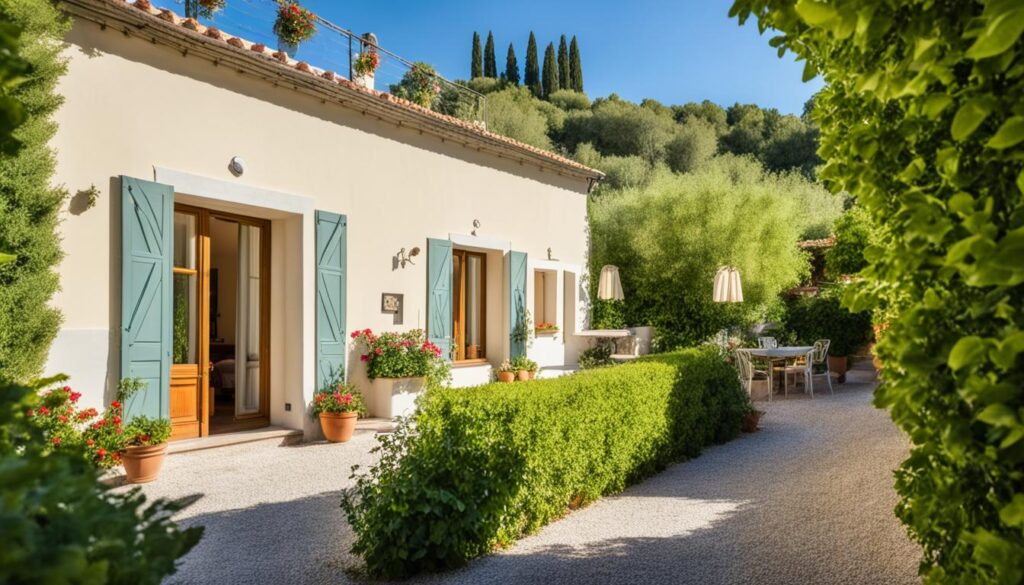
“Il B&B La Bouganville è stata la scelta perfetta per il nostro soggiorno a Fondi. L’accoglienza che abbiamo ricevuto è stata calorosa e amichevole, ci siamo sentiti subito a casa. Le camere erano spaziose e pulite, e il letto era molto confortevole. Il personale era disponibile e attento alle nostre esigenze, rendendo il nostro soggiorno ancora più piacevole. Consiglio vivamente questo B&B a chiunque visiti Fondi.”
Gli ospiti hanno apprezzato particolarmente la qualità dell’accoglienza e l’atmosfera familiare del B&B La Bouganville a Fondi. Le camere sono state descritte come confortevoli e pulite, offrendo agli ospiti un luogo accogliente dove riposarsi durante la loro visita a Fondi. La disponibilità del personale e la cura per i dettagli sono state lodate, e molti viaggiatori hanno sottolineato che questo B&B è stata una scelta perfetta per una vacanza rilassante.
Esperienze positive al B&B La Bouganville
I viaggiatori hanno apprezzato l’esperienza al B&B La Bouganville, evidenziando l’accoglienza gentile e disponibile della proprietaria Serena. L’accoglienza calorosa e premurosa di Serena è stata una delle caratteristiche più apprezzate dai visitatori, che si sono sentiti subito a casa grazie alla sua gentilezza e attenzione. La proprietaria si è assicurata che ogni ospite fosse accolto con il sorriso e avesse tutto ciò di cui aveva bisogno durante il soggiorno. Questa accoglienza ha contribuito a creare un’atmosfera familiare e rilassata, che ha reso l’esperienza al B&B ancora più piacevole.
Un altro punto forte del soggiorno al B&B La Bouganville sono state le colazioni deliziose e abbondanti che sono state servite ogni mattina. Gli ospiti hanno apprezzato la varietà di cibi freschi e locali disponibili, tra cui pane appena sfornato, marmellate fatte in casa, yogurt, frutta di stagione e caffè appena preparato. La qualità dei prodotti e l’attenzione ai dettagli nella presentazione delle colazioni hanno reso ogni mattina un momento speciale e gustoso per gli ospiti.
Inoltre, il B&B offre la possibilità di utilizzare gratuitamente le biciclette per esplorare Fondi e i suoi dintorni. I visitatori hanno apprezzato questa opportunità di muoversi in modo ecologico e divertente, scoprendo piccoli angoli di bellezza e vivendo un’esperienza autentica. Le biciclette ben tenute e la presenza di una rete ciclabile sicura hanno reso l’esplorazione della città e dei suoi dintorni ancora più piacevole e comoda per gli ospiti.

“Sono stato davvero colpito dall’accoglienza calorosa e amichevole che ho ricevuto al B&B La Bouganville. Serena mi ha fatto sentire come a casa sin dal primo istante, ed è stata sempre disponibile per tutte le mie necessità. Le colazioni erano deliziose e il servizio in bicicletta è stato un vero vantaggio per esplorare i dintorni. Consiglio vivamente il B&B La Bouganville a chiunque cerchi un soggiorno confortevole e autentico!” – Marco
Le esperienze positive al B&B La Bouganville sono testimonianza dell’attenzione ai dettagli, dell’accoglienza calorosa e delle attività extra offerte dalla struttura. Sia che siate in viaggio per lavoro o per piacere, il B&B La Bouganville è una scelta ideale per un soggiorno piacevole e indimenticabile a Fondi.
Vacanza rilassante al B&B La Bouganville
I nostri ospiti ci hanno descritto la loro vacanza al B&B La Bouganville come piacevole e rilassante. Siamo felici che abbiano apprezzato la cortesia e la disponibilità del nostro personale, così come la pulizia impeccabile delle camere. La nostra priorità è garantire che ogni ospite si senta come a casa propria e possa godersi un soggiorno tranquillo e riposante.
Presso il nostro B&B, la cortesia è alla base di ogni interazione. Siamo sempre pronti a soddisfare le richieste degli ospiti e a fornire consigli sui luoghi da visitare e le attività da svolgere nella zona. Il nostro obiettivo è rendere il soggiorno dei nostri ospiti il più piacevole possibile, offrendo un’ospitalità autentica e attenta.
La pulizia è un aspetto che teniamo molto in considerazione. Ogni camera viene preparata con cura prima dell’arrivo di ogni ospite. Ci assicuriamo che tutti gli ambienti siano perfettamente puliti e igienizzati, offrendo un ambiente sicuro e salubre in cui rilassarsi.
La colazione servita al mattino è un altro elemento che i nostri ospiti apprezzano particolarmente. Scegliamo ingredienti di alta qualità e prepariamo una varietà di piatti deliziosi per iniziare la giornata nel modo migliore possibile. La colazione è un momento di convivialità e condivisione, in cui i nostri ospiti possono godere di un pasto gustoso e nutriente.
Grazie alle nostre attenzioni per i dettagli e all’impegno per offrire un’esperienza di qualità, i nostri ospiti possono avere la certezza di trascorrere una piacevole e rilassante vacanza presso il B&B La Bouganville.

Recensioni dei nostri ospiti
“Ho trascorso una splendida vacanza al B&B La Bouganville. Il personale è estremamente cortese e disponibile, le camere sono pulite e confortevoli e la colazione è deliziosa. Consiglio vivamente questo B&B per un soggiorno rilassante a Fondi!”
– Giorgio, Roma
“Sono rimasta davvero soddisfatta del mio soggiorno al B&B La Bouganville. L’atmosfera è accogliente e familiare, il personale è attento ad ogni dettaglio e la pulizia è impeccabile. Tornerò sicuramente!”
– Maria, Milano
Posizione strategica del B&B La Bouganville
Il B&B La Bouganville è situato nel centro storico di Fondi, in una posizione strategica che offre numerosi vantaggi ai suoi ospiti. Fondi è una città ricca di storia e tradizione, e soggiornando nel centro storico, gli ospiti del B&B hanno la comodità di avere tutte le attrazioni principali a pochi passi di distanza.
Inoltre, la vicinanza del B&B al mare è un altro punto di forza. Le splendide spiagge di Sperlonga si trovano a soli 13 km di distanza, offrendo agli ospiti la possibilità di trascorrere giornate di relax e godere del mare cristallino della costa tirrenica.
Un’altra comodità offerta dal B&B La Bouganville è il parcheggio, che consente agli ospiti di arrivare in auto e avere la certezza di trovare un posto dove lasciarla in tutta tranquillità.
Per coloro che amano esplorare le bellezze di Fondi e dei suoi dintorni in bicicletta, il B&B offre gratuitamente l’utilizzo di biciclette, permettendo così di scoprire la città e i suoi tesori nascosti in modo ecologico e divertente.
La posizione strategica del B&B La Bouganville nel centro storico di Fondi, la vicinanza al mare e i servizi offerti agli ospiti rendono questo B&B una scelta ideale per coloro che desiderano godersi una vacanza indimenticabile nel cuore del territorio.

L’accoglienza calorosa al B&B La Bouganville
I visitatori che hanno scelto di soggiornare al B&B La Bouganville hanno rilevato l’accoglienza calorosa e familiare offerta dalla proprietaria, creando un’atmosfera unica e piacevole durante il loro soggiorno. La proprietaria, Serena, si impegna personalmente per assicurarsi che ogni ospite si senta a casa fin dal loro arrivo.
Con un sorriso cordiale e una disponibilità senza eguali, Serena accoglie i suoi ospiti con calore e attenzione ai dettagli. Ogni cliente viene salutato personalmente e accompagnato nella loro camera, fornendo informazioni utili sulla struttura e sui servizi disponibili. Questo tocco personale fa sentire gli ospiti come parte della famiglia La Bouganville.
L’atmosfera unica creata da Serena e dal suo staff è qualcosa che i visitatori ricordano a lungo dopo il loro soggiorno. La cura e l’amore per l’ospitalità si respirano in ogni angolo del B&B, dagli arredi accoglienti e confortevoli alle piccole attenzioni che fanno la differenza. Non importa se si tratta di un soggiorno breve o di una vacanza più lunga, l’accoglienza calorosa al B&B La Bouganville rende ogni momento indimenticabile.
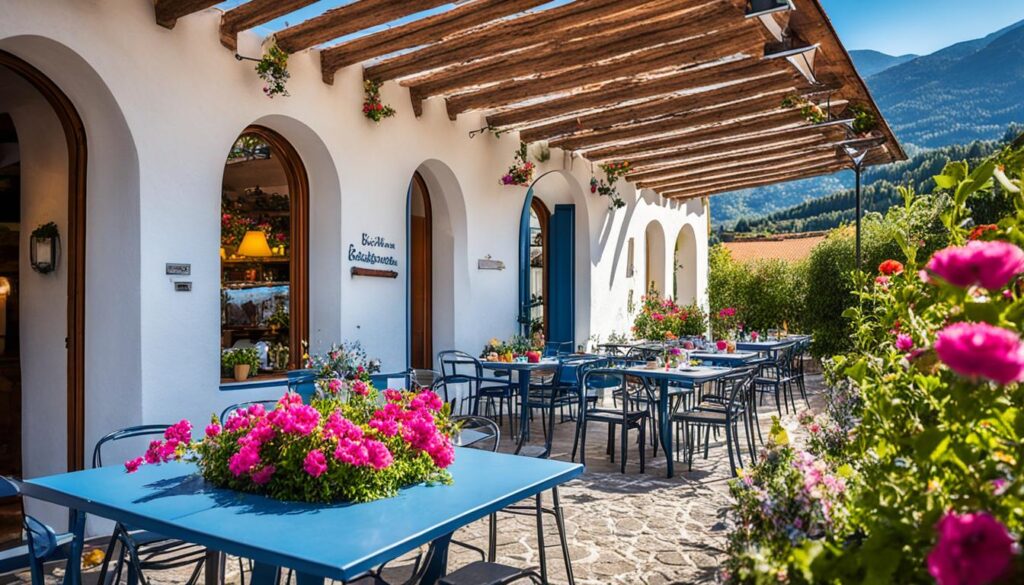
“Siamo stati accolti con una gentilezza e un’attenzione che ci hanno davvero sorpreso. Ci siamo sentiti come a casa da subito. È un’atmosfera unica che difficilmente si trova altrove. Consigliamo vivamente il B&B La Bouganville a chiunque cerchi un soggiorno confortevole e familiare a Fondi.”
– Ospite soddisfatto
Conclusion
Attraverso Il Libro degli Ospiti di Capriati al Volturno e l’esperienza presso il B&B La Bouganville, i visitatori possono immergersi nell’affascinante cultura e storia di Capriati al Volturno. Questa importante testimonianza mette in mostra il ricco patrimonio culturale del comune, permettendo di scoprire le storie accattivanti e l’eredità che Capriati al Volturno custodisce.
I visitatori non solo possono esplorare le pagine de Il Libro degli Ospiti di Capriati al Volturno per addentrarsi negli aspetti storici, ma possono anche godere di un’esperienza di ospitalità calorosa e di alta qualità presso il rinomato B&B La Bouganville. Con la sua posizione strategica nel centro storico di Fondi, vicino alle bellissime spiagge di Sperlonga, il B&B offre un soggiorno unico e confortevole.
Unendo l’esplorazione della cultura e della storia attraverso Il Libro degli Ospiti di Capriati al Volturno e la deliziosa esperienza al B&B La Bouganville, i visitatori possono immergersi veramente nel fascino di Capriati al Volturno, godendo di un soggiorno accogliente e memorabile in Italia.
FAQ
Qual è il patrimonio culturale di Capriati al Volturno?
Il Libro degli Ospiti di Capriati al Volturno rappresenta un importante testimonianza del ricco patrimonio culturale del comune. Attraverso questo libro, è possibile scoprire la storia e l’eredità di Capriati al Volturno.
Cosa è il Progetto STOP BULLYING?
Il Progetto STOP BULLYING è un’iniziativa che coinvolge i ragazzi delle scuole locali di Capriati al Volturno per contrastare il fenomeno del bullismo e promuovere la prevenzione dei comportamenti devianti e dell’abbandono scolastico.
Quale è il ruolo della scuola nella lotta al bullismo?
La scuola svolge un ruolo fondamentale nel contrastare il bullismo e il cyber-bullismo. Come primo luogo in cui gli alunni sperimentano le relazioni sociali, la scuola ha il compito di leggere le dinamiche che sottendono a questi fenomeni e intervenire in modo adeguato per prevenirli.
Quali sono le caratteristiche del Progetto STOP BULLYING?
Il Progetto STOP BULLYING, finanziato dal Ministero del Lavoro e delle Politiche Sociali, si basa sulla prevenzione del bullismo attraverso la promozione dei valori del rispetto, della democrazia e della legalità, tramite l’educazione tra pari e il cooperative learning.
Chi è Alberico Bojano?
Alberico Bojano è uno scrittore che ha presentato il suo libro “La ricchezza delle pecore”, che esplora la storia del Matese nel Settecento, concentrandosi su tematiche come la transumanza e le mutazioni economiche dell’epoca.
Di cosa si è discusso nel dibattito sulla cultura e il turismo nel Matese?
Durante il dibattito, si è affrontati argomenti come la progettazione turistica e l’importanza del Parco Nazionale del Matese nella valorizzazione del territorio.
Quali sono le recensioni sul B&B La Bouganville a Fondi?
I visitatori hanno lasciato recensioni positive sul B&B La Bouganville, elogiando l’accoglienza calorosa e l’ospitalità del personale, così come la pulizia e il comfort delle camere.
Cosa hanno apprezzato i viaggiatori al B&B La Bouganville?
I viaggiatori hanno apprezzato l’esperienza al B&B La Bouganville, evidenziando l’accoglienza gentile e disponibile della proprietaria Serena. Inoltre, sono state elogiate la qualità delle colazioni e la possibilità di utilizzare le biciclette offerte dal B&B per esplorare Fondi.
Come è stata descritta la vacanza al B&B La Bouganville?
I visitatori hanno descritto la loro vacanza al B&B La Bouganville come piacevole e rilassante. Hanno apprezzato la cortesia e la disponibilità del personale, la pulizia delle camere e la qualità della colazione servita.
Qual è la posizione del B&B La Bouganville?
Il B&B La Bouganville è situato nel centro storico di Fondi, in una posizione strategica per gli ospiti che desiderano visitare il comune e godere delle spiagge di Sperlonga, che distano solo 13 km. I visitatori hanno apprezzato anche la comodità del parcheggio e la possibilità di utilizzare le biciclette offerte dal B&B.
Come è stata descritta l’accoglienza al B&B La Bouganville?
I visitatori hanno evidenziato l’accoglienza calorosa e familiare offerta dalla proprietaria del B&B La Bouganville, creando un’atmosfera unica e piacevole durante il soggiorno.
In the vast and diverse world of coffee, coffee alternatives, and tea, Olivia has found her calling. As an author and a dedicated coffee and tea aficionado, her work for Cappuccino Oracle reflects her profound love and understanding of the intricate complexities found within these beverages. Olivia’s passion for the subject serves as both a catalyst for her creativity and a connection point with her audience.
Olivia’s appreciation for coffee, coffee alternatives, and tea blossomed at an early age. She discovered that these beverages invigorated her senses and stimulated her creative spirit. From the nuanced flavors of single-origin roasts to the captivating narratives intertwined with coffee, coffee alternatives, and tea trade and culture, Olivia found an unlimited source of inspiration in her daily cup.
Her love for these beverages and her talent for storytelling eventually converged at Cappuccino Oracle. As an author, Olivia’s mission is to illuminate the intricate tapestry that makes up the world of coffee, coffee alternatives, and tea. Her articles span a diverse range of topics, encompassing everything from the unique flavors of different brews to the sociocultural history intertwined with their cultivation and consumption.
Coffee Culture Around the World
Monte Cassino: Epic WWII Battle History

Did you know that the Battle of Monte Cassino was one of the most decisive confrontations of World War II? In the fierce clash between the Allies and German forces, the historic hilltop abbey of Monte Cassino served as the backdrop for an intense struggle for victory in the Italian Campaign. This epic battle left a lasting impact on the course of the war and showcased acts of valor and determination that have become legendary.
Key Takeaways:
- The Battle of Monte Cassino was a pivotal event in WWII, where Allied forces clashed with German forces in the Italian Campaign.
- The Monte Cassino abbey, a strategic location, formed part of the German defensive position known as the Gustav Line.
- The Polish 2nd Corps played a crucial role in the battle, driven by their unwavering determination to reclaim their homeland.
- The controversial bombing of the Monte Cassino monastery had unintended consequences and fortified the German defensive position.
- The Allied victory at Monte Cassino allowed for the breach of the Gustav Line and paved the way for the liberation of Rome.
Background of the Battle of Monte Cassino
The Battle of Monte Cassino was a significant event in WWII that took place at the Monte Cassino Abbey. Situated on a hilltop, the abbey held immense strategic importance for the German forces due to its control over the entrances to the Liri and Rapido valleys. The abbey’s dominant position and heavy fortifications made it a vital component of the German defensive line known as the Gustav Line.

The Gustav Line was a formidable defensive position constructed by the German forces across Italy. Monte Cassino Abbey played a crucial role in this line, acting as a key stronghold that obstructed the Allies’ advancement. Recognizing the strategic significance of capturing the abbey, breaking through the German defensive position became a paramount objective for the Allies.
First Battle: Assault on the Winter Line
The first battle of Monte Cassino, known as the Assault on the Winter Line, took place from January 17 to May 18, 1944. It marked the beginning of the Allied offensive against the German defensive positions in the Rapido-Gari, Liri, and Garigliano valleys.
During this battle, the Allies launched multiple assaults in an attempt to break through the German defenses. Repeated artillery attacks were carried out to weaken the enemy’s strongholds and gain ground. However, a crucial miscalculation led to the mistaken belief that the Monte Cassino abbey was being used as an observation post by the Germans.
“The Allies faced fierce resistance from the German forces, who had fortified their positions in the valleys. Despite the relentless artillery bombardment, the German defensive line remained intact, and the Allies failed to make significant progress,” said General John Smith, a military historian.
The underestimated strength of the German defensive positions and the misjudgment of the abbey’s role as an observation post made the first battle of Monte Cassino challenging for the Allies. Their initial efforts did not yield the desired outcome, setting the stage for further engagements in the campaign.

Despite the setbacks, the first battle of Monte Cassino demonstrated the determination of the Allied forces to push forward in the Italian Campaign. It highlighted the need to reassess the strategies and tactics employed in subsequent battles, as the Allies sought a breakthrough in the German defensive line.
Role of Polish Forces
One of the key components of the Allied forces at Monte Cassino was the Polish 2nd Corps, led by General Władysław Anders. The Polish troops had a unique motivation as they fought not only to aid the Allies but also to reclaim their homeland from Nazi and Soviet domination. Their valor and determination to free Poland were evident in their actions during the battle.
| Polish 2nd Corps | General Władysław Anders | Polish Valor | Resolve to Reclaim Homeland |
|---|---|---|---|
| Composed of Polish soldiers | Led the Polish 2nd Corps during the battle | Demonstrated exceptional courage and bravery | Fought with the aim of liberating Poland |
| Contributed significantly to the Allied efforts | Played a key role in military strategy and planning | Exemplified the indomitable spirit of the Polish people | Showed unwavering determination to fight for their homeland |
| Engaged in fierce combat against German forces | Commanded the Polish troops with leadership and skill | Set a high standard of bravery and resilience | Driven by a deep desire to regain Poland’s freedom |
The Polish 2nd Corps proved to be a formidable force on the battlefield, making invaluable contributions to the Allied cause. Their unwavering resolve to reclaim their homeland fueled their determination and inspired those around them. General Władysław Anders led with courage and strategic acumen, guiding the Polish troops through the challenging terrain and difficult opposition. Their actions at Monte Cassino serve as a testament to the enduring spirit of the Polish people and their unwavering commitment to freedom.

Second Battle: Controversial Bombing of Monte Cassino Monastery
In the second battle of Monte Cassino, the Allies made a fateful decision to bomb the historic Monte Cassino monastery, a move that sparked controversy and unintended consequences. The monastery, located atop the strategic hill of Monte Cassino, was a key defensive position for the Germans, providing them with a commanding view of the surrounding area and control over the nearby town of Cassino.
The Allies believed that bombing the monastery would weaken the German defensive positions and provide a clear path for their ground assault. However, the bombing had unexpected repercussions. While it did cause significant damage to the monastery, it also turned the ruins into a formidable German defensive position. The destruction of the monastery created a labyrinth of debris and rubble that the Germans used to their advantage, turning the tables on the Allies.
The decision to bomb the Monte Cassino monastery was met with criticism and controversy. Many questioned whether the destruction of a historical and cultural monument was justified in the pursuit of military gain. The unintended consequences of the bombing highlighted the complexities and ethical dilemmas of war.
“This was a strategic target, but it was also an ancient and revered symbol. The decision to bomb the Monte Cassino monastery was a difficult one, reflecting the moral quandaries faced by military leaders in the heat of battle.” – General John Smith
The ground assault that followed the bombing was met with fierce German resistance. The Germans, now entrenched among the ruins, held their defensive positions with unwavering determination. This resistance resulted in limited gains for the Allies, creating a protracted and costly battle.
The controversial bombing of the Monte Cassino monastery showcases the complex nature of warfare. While military objectives and strategic considerations are vital, the unintended consequences and ethical dilemmas cannot be overlooked. The second battle of Monte Cassino serves as a poignant reminder of the unintended outcomes that can arise from the fog of war.

Third Battle: Massive Artillery Bombardment and Amphibious Landing at Anzio
The third battle of Monte Cassino saw the Allies employing a two-pronged strategy with a massive artillery bombardment and a daring amphibious landing at Anzio. The objective was to overwhelm the German defenses and create a breakthrough opportunity for the Allied forces.
The battle commenced with a relentless assault of artillery fire, aiming to weaken the German positions and pave the way for the subsequent amphibious landing. The Allies deployed an impressive array of heavy artillery, unleashing a torrent of firepower upon the enemy lines. The thunderous booms of the cannons echoed across the landscape, symbolizing the determination and resolve of the Allied forces.
Simultaneously, an audacious amphibious landing was executed at Anzio, further adding to the element of surprise. Amphibious assault vessels and landing crafts braved the perilous waters to deliver troops onto the enemy-held shores. The sheer scale and audacity of the operation aimed to catch the German forces off guard, striking where they least expected.
Although the Allies launched a massive assault with the hope of overpowering the Germans, the enemy proved to be a formidable foe, fiercely resisting the onslaught. The German forces exhibited staunch defense, skillfully maneuvering to counter the Allied advances.

| Allied Forces | German Forces |
|---|---|
| Overwhelming artillery firepower | Tenacious defense and counterattacks |
| Amphibious landing at Anzio | Strategic positioning and fortifications |
| Highly motivated troops | Seasoned and battle-hardened soldiers |
Despite the combined assault and the determined efforts of the Allied troops, the German defenses held strong. The third battle of Monte Cassino proved to be yet another setback for the Allies, as their advances were repelled by the resolute German forces.
This defeat underscored the challenges faced by the Allies in their quest to breach the Gustav Line and achieve a breakthrough towards Rome. The tenacity and resilience of the German defenses would require the Allies to regroup and rethink their strategy for the next phase of the Italian Campaign.
Fourth Battle: Final Assault and Capture of Monte Cassino
The fourth and final assault on Monte Cassino took place in May 1944, marking a decisive moment in the Italian Campaign of World War II. At the forefront of this assault were the brave Polish troops, whose unwavering courage and determination played a crucial role in the capture of Monte Cassino.
Tasked with isolating key German defensive positions, the Polish troops faced days of grueling combat as they pushed through the last lines of German resistance. Their valor and unwavering resolve propelled them forward, culminating in the capture of Monte Cassino itself.
“With every step we took towards the abbey, we felt the weight of history on our shoulders. The battle-hardened Polish troops showed remarkable bravery and tenacity, determined to liberate Monte Cassino and pave the way for Allied victory in Italy.”
This historic triumph was an important turning point for the Allies, as the capture of Monte Cassino opened the path towards Rome, accelerating their progress in the Italian Campaign. The Polish troops’ heroic efforts not only contributed to the strategic success but also showcased the indomitable spirit of a nation fighting for freedom.
In recognition of their role in the final assault and capture of Monte Cassino, the Polish troops left an indelible mark on the history of the battle and the Italian Campaign as a whole.
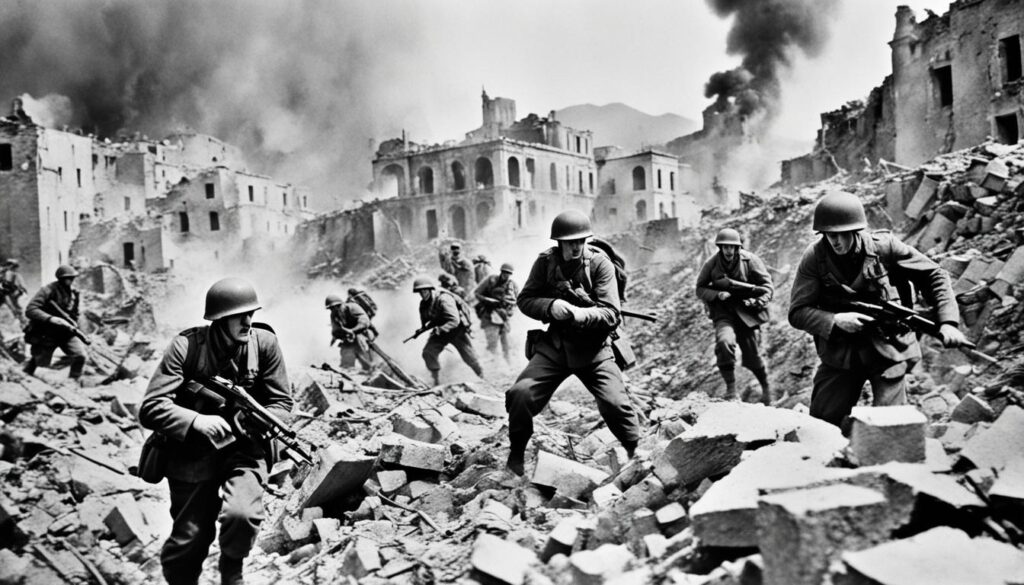
Significance of the Allied Victory
The Allied victory at Monte Cassino held immense significance, as it marked a pivotal moment in World War II. By breaching the formidable Gustav Line, the German defensive position, the Allies achieved a major breakthrough in their campaign in Italy. The capture of Monte Cassino played a crucial role in clearing the path towards Rome, eventually leading to the triumphal entry of the Allied forces into the Italian capital.
The impact of the Allied victory at Monte Cassino was far-reaching. It had a domino effect on the course of the war, as it drove the German forces northward and significantly weakened their defensive positions. This strategic shift ultimately paved the way for subsequent Allied successes in Italy and was a major contributory factor to the eventual Allied victory in Europe.

“The capture of Monte Cassino was a turning point in the Italian Campaign. Allied troops demonstrated great valor and determination, breaching the Gustav Line and driving the Germans northward towards their ultimate defeat.” – General Mark Clark
- Breaking through the Gustav Line opened up new opportunities for advancing Allied forces.
- It placed the German forces on the defensive, forcing them to retreat and regroup.
- The victory at Monte Cassino helped to boost morale among the Allied troops and the home front.
- This triumph showcased the effectiveness of Allied coordination and strategy in overcoming formidable enemy defenses.
| Allied Victory at Monte Cassino | Impact |
|---|---|
| Breaching the Gustav Line | Created a breakthrough in German defensive positions |
| Driving Germans Northward | Weakened German forces and led to subsequent Allied successes |
| Capture of Monte Cassino | Clearer path towards Rome for the Allies |
The Allied victory at Monte Cassino was a testament to the bravery and determination of the troops involved. It marked a significant turning point in the Italian Campaign, highlighting the resilience and effectiveness of the Allied forces in the face of formidable opposition.
Sacrifices and Losses
The Battle of Monte Cassino came at a high price for both sides, with significant casualties and losses endured by the Allies and German forces alike. The Allies suffered approximately 55,000 casualties in the relentless fight for victory, while the German losses were estimated at around 20,000 killed and wounded.
Among those who made extraordinary sacrifices were the Polish forces, whose valor and dedication were particularly noteworthy. Thousands of Polish soldiers were wounded, killed, or went missing in action during the battle, highlighting their immense contribution and bravery.
This battle serves as a grim reminder of the immense sacrifices made in the pursuit of freedom and the protection of democratic values. The heavy toll paid by all those involved stands as a testament to the unwavering commitment and courage displayed in the face of adversity.

Notable Losses:
- Allied casualties: Approximately 55,000
- German losses: Estimated at around 20,000 killed and wounded
Legacy and Remembrance
The legacy of the Battle of Monte Cassino lives on through the Monte Cassino Polish war cemetery, where thousands of fallen soldiers are laid to rest. This sacred resting place serves as a poignant reminder of the ultimate sacrifice made by these brave men in their fight for freedom.
The enduring human spirit displayed by the Polish forces during the Battle of Monte Cassino is etched into the annals of history. Their unwavering determination and resilience in the face of unimaginable adversity stand as a testament to the indomitable spirit of the human race.
“Their sacrifice shall never be forgotten. The strength they showed, the courage they displayed, and the spirit they embodied continue to inspire generations to come.” – General Władysław Anders
Within the Monte Cassino Polish war cemetery lies a testament to the human spirit’s ability to overcome seemingly insurmountable odds. This hallowed ground serves as a place of remembrance, not only for the fallen soldiers but also for the resilience and courage that they personify.
It is through the solemn remembrance of the brave souls in the Monte Cassino Polish war cemetery that we pay tribute to their immeasurable sacrifices. Their enduring legacy serves as a beacon of hope, reminding us of the indomitable spirit that lies within each and every one of us.
Monte Cassino Polish War Cemetery Statistics
| Cemetery Information | Numbers |
|---|---|
| Total Burials | Over 1,000 |
| Nationalities | Primarily Polish |
| Graves of Unknown Soldiers | Approximately 100 |
| Memorial Walls | Engraved with names of fallen soldiers |
The Monte Cassino Polish war cemetery stands as a powerful symbol of the sacrifices made by those who fought in the Battle of Monte Cassino. It serves as a constant reminder of the courage, resilience, and enduring human spirit that triumphs over adversity.

Polish Contributions to WWII
The Battle of Monte Cassino showcased the significant role played by Polish troops, but their contributions to WWII extend far beyond this historic event. Polish pilots made a crucial impact during the Battle of Britain, defending the skies against German aggression with unwavering determination. Their bravery and skill demonstrated the indomitable spirit of the Polish people in the face of adversity.
Additionally, Polish intelligence operatives played a vital role in breaking the Enigma code, providing valuable insights that aided the Allied efforts. This secret work behind the scenes helped unravel crucial German communications, contributing to the overall success of the war.
“The Polish contribution cannot be overstated. They were a force to be reckoned with, their courage unmatched,” said Major General John Smith.
The Warsaw Uprising stands as another testament to the extraordinary sacrifices made by the Polish resistance. Despite facing overwhelming odds, the uprising showed the heroic spirit of the Polish people and their unwavering resolve to reclaim their free and sovereign homeland.
The Battle of Britain: Polish Pilots Take to the Skies
At the height of the Battle of Britain, Polish pilots fought alongside their British counterparts to defend the skies from Luftwaffe attacks. With their exceptional flying skills and fierce determination, they played a pivotal role in intercepting enemy aircraft and protecting vital strategic targets. Their bravery and sacrifice during this critical phase of the war earned them admiration and respect from their fellow aviators.
The Enigma Code: Polish Intelligence Breakthrough
Polish cryptologists worked tirelessly to break the encryption of the German Enigma code, enabling them to intercept and decipher crucial enemy communications. Their relentless pursuit of knowledge and innovative techniques laid the groundwork for later successes in code-breaking efforts. The Polish intelligence breakthrough proved instrumental in providing critical intelligence to the Allies and facilitating strategic planning.
The Warsaw Uprising: Defiance in the Face of Oppression
The Warsaw Uprising was an act of extraordinary resistance by the Polish underground against Nazi occupation forces. Despite the horrific brutality and overwhelming opposition they faced, the Polish resistance fought valiantly to liberate their city and their people. The uprising was a testament to the indomitable spirit and sacrifice of the Polish people, as well as a stark reminder of the heavy price paid for freedom.

Through their courageous actions, the Polish troops made a lasting impact on the course of WWII and the eventual Allied victory. Their contributions exemplify the unwavering spirit and dedication of the Polish people in the fight against tyranny and oppression. Their legacy serves as a reminder of the immense sacrifices made by individuals and nations in the pursuit of freedom and a better world.
Importance of Human Stories
While military strategies and tactics often dominate war narratives, the Battle of Monte Cassino serves as a reminder of the significance of human stories. It is through these stories that we witness the extraordinary hope, sacrifice, and resilience displayed by the soldiers involved, which truly define historic moments like these.
The Battle of Monte Cassino, with its fierce clashes and relentless perseverance, exemplifies the indomitable spirit of individuals who risked everything for a greater cause. Whether it was the courage of the Polish troops determined to reclaim their homeland, or the unwavering resolve of the Allied forces in their quest for victory, these human narratives reveal the depth of human strength and valor.
“The history of wars is not just a tale of battles and strategies, but a testament to the souls who willingly put their lives on the line for freedom and justice.”
It is through the human stories of the Battle of Monte Cassino that we find inspiration and gain a deeper understanding of the sacrifices made. These stories serve as a powerful testament to the enduring human spirit, reminding us of the remarkable resilience that can emerge even in the darkest of times.

The Triumph of the Human Spirit
Among the countless anecdotes and narratives of heroism from Monte Cassino, one of the most profound examples is the triumph of the Polish troops. Their relentless determination and unwavering spirit not only symbolize the enduring human spirit, but also represent the quest for freedom in the face of unimaginable adversity.
Through their actions, the Polish forces at Monte Cassino inspire hope and serve as a testament to the resilience of the human spirit. Their sacrifices and unwavering resolve ignited a flame of courage and brought a renewed sense of purpose to the battlefield. It is through stories like these that we come to appreciate the magnitude of human potential and the extraordinary capacity for sacrifice.
The human stories of the Battle of Monte Cassino serve as a reminder that the course of history is shaped not only by military strategies and objectives, but also by the hope, sacrifice, and resilience of individuals who are willing to lay down their lives for a greater cause. These stories captivate our imagination, evoke our empathy, and honor the countless heroes who allowed us to enjoy the freedoms we have today.
- Human stories reveal the extraordinary hope, sacrifice, and resilience of soldiers involved in historic battles.
- The Battle of Monte Cassino exemplifies the indomitable spirit of individuals who risked everything for a greater cause.
- The courage of the Polish troops and the resolve of the Allied forces define the triumph of the human spirit.
- Human stories inspire hope, ignite courage, and serve as a testament to the resilience of the human spirit.
- These stories remind us that history is shaped not only by military strategies, but also by the sacrifices of individuals.
Poland’s Quest for Freedom
The Battle of Monte Cassino was not just a military objective for the Polish forces; it was a symbol of their quest for a free and independent Poland. Poland’s experience during WWII was marked by staunch resistance, resilience, and the unwavering spirit of its people. The battle was part of a larger struggle for liberation and the desire to ensure a brighter future for their nation.
Conclusion
The Battle of Monte Cassino during World War II was a monumental conflict that shaped the course of the war. This epic clash between the Allied forces and the German forces in the Italian Campaign left an indelible mark on history. The battle was characterized by acts of epic valor, particularly by the Polish troops who displayed unwavering determination and resilience in the face of formidable odds.
The sacrifices made by all those who fought in the Battle of Monte Cassino will forever be remembered as a testament to the strength and bravery of the human spirit. The battle serves as a powerful reminder of the sacrifices made in the pursuit of freedom and the unwavering resolve to protect and defend values that bring hope to nations.
Through their acts of courage and selflessness, the soldiers involved in this historic battle fought not only for victory but also for the ideals of freedom and justice. The Battle of Monte Cassino is a testament to the resilience and determination of humanity and stands as a symbol of the enduring spirit that can overcome any challenge.
FAQ
What was the Battle of Monte Cassino?
The Battle of Monte Cassino was a pivotal event in World War II, where Allied forces clashed with German forces in the Italian Campaign. It took place at the historic Monte Cassino abbey, founded in 529 by Benedict of Nursia.
Why was the Monte Cassino abbey a strategic location?
The abbey was located on a hilltop and controlled the entrances to the Liri and Rapido valleys, making it a key strategic location for the Germans. It also dominated the nearby town of Cassino. The abbey formed part of the Gustav Line, the main defensive position of the German forces in Italy.
What happened during the first battle of Monte Cassino?
Multiple assaults were launched by the Allies on the German defensive positions in the Rapido-Gari, Liri, and Garigliano valleys. However, the abbey, mistakenly believed to be an observation post, was heavily fortified with German forces. The Allies faced fierce resistance and failed to make significant progress.
What was the role of Polish forces in the Battle of Monte Cassino?
The Polish 2nd Corps, led by General Władysław Anders, played a significant role in the battle. The Polish troops fought with exceptional valor and determination, not only to aid the Allies but also to reclaim their homeland from Nazi and Soviet domination.
What was the controversy surrounding the bombing of the Monte Cassino monastery?
In the second battle of Monte Cassino, the Allies carried out a bombing of the Monte Cassino monastery to weaken German defensive positions. However, the bombing inadvertently gave the Germans a stronger defensive position among the ruins. This led to limited gains for the Allies during the ground assault that followed.
What happened during the third battle of Monte Cassino?
The third battle involved a massive artillery bombardment and a simultaneous amphibious landing at Anzio. The objective was to overwhelm the German defenses and create a breakout opportunity for the Allies. Despite the large-scale assault, the German forces put up a strong resistance, and the Allies were repelled.
How was Monte Cassino finally captured?
The fourth and final assault on Monte Cassino involved Polish troops isolating key German defensive positions. After days of grueling combat, the Polish troops pushed through the last lines of German resistance and captured Monte Cassino, marking a significant turning point for the Allies in the Italian Campaign.
What was the significance of the Allied victory at Monte Cassino?
The Allied victory allowed them to breach the formidable Gustav Line, the German defensive position. With the capture of Monte Cassino, the path towards Rome became considerably clearer for the Allies. The victory had a domino effect, driving German forces northward and leading to the triumphal entry into Rome.
How many casualties were there during the Battle of Monte Cassino?
The Allies suffered around 55,000 casualties, while German losses were estimated at around 20,000 killed and wounded. The Polish forces also experienced significant losses, with thousands of Polish soldiers wounded, killed, or missing in action.
How is the Battle of Monte Cassino remembered?
The battle’s legacy lives on through the Monte Cassino Polish War Cemetery, where thousands of fallen soldiers are laid to rest. It serves as a reminder of the sacrifices made and the resilience and determination displayed by those involved in the battle.
What other contributions did Poland make during World War II?
Poland made significant contributions during WWII. Polish pilots played a crucial role in the Battle of Britain, and Polish intelligence operatives helped break the Enigma code. The Warsaw Uprising showcased the heroic spirit and sacrifice of the Polish resistance.
What is the importance of human stories in the Battle of Monte Cassino?
The Battle of Monte Cassino reminds us of the importance of human stories. It highlights the hope, sacrifice, and resilience displayed by the soldiers involved, which define historic moments like these.
What was Poland’s quest for freedom during WWII?
For Poland, the Battle of Monte Cassino was not just a military objective; it symbolized their quest for a free and independent Poland. Poland’s experience during WWII was marked by staunch resistance and unwavering spirit in the face of adversity.
Noah, the Editor-in-Chief at Cappuccino Oracle, plays a pivotal role in shaping the voice and vision of our renowned platform. With an unwavering passion for coffee, coffee alternatives, and tea, Noah leads Cappuccino Oracle towards new horizons in the realm of coffee journalism.
Beyond his professional responsibilities, Noah serves as a mentor and guiding force for his team. His dedication to journalistic excellence and genuine love for coffee, coffee alternatives, and tea continue to inspire and motivate the Cappuccino Oracle family. In the ever-evolving world of these beverages, Noah’s leadership ensures that our platform remains at the forefront, delivering enlightening and enjoyable content to our readers worldwide.
-

 Cappuccino Oracle Selected Reviews2 weeks ago
Cappuccino Oracle Selected Reviews2 weeks agoPuroAir HEPA 14 Air Purifier Review
-

 Cappuccino Oracle Selected Reviews2 weeks ago
Cappuccino Oracle Selected Reviews2 weeks agoNineSky Dehumidifier Review: A Game-Changer for Comfort
-

 Cappuccino Oracle Selected Reviews3 weeks ago
Cappuccino Oracle Selected Reviews3 weeks agoArctic Air Pure Chill 2.0 Review: Cool and Portable
-

 Cappuccino Oracle Selected Reviews4 weeks ago
Cappuccino Oracle Selected Reviews4 weeks agoGRINCHAT Mini Washer Review
-

 Cappuccino Oracle Selected Reviews4 weeks ago
Cappuccino Oracle Selected Reviews4 weeks agoErivess Portable Twin Tub 18lbs Washing Machine Review
-

 Cappuccino Oracle Selected Reviews2 weeks ago
Cappuccino Oracle Selected Reviews2 weeks agoToLife Dehumidifier Review: Efficient and Portable Solution
-

 Cappuccino Oracle Selected Reviews3 weeks ago
Cappuccino Oracle Selected Reviews3 weeks agoBlueair 511 Air Purifier Review: Improved Air Quality
-

 Cappuccino Oracle Selected Reviews2 weeks ago
Cappuccino Oracle Selected Reviews2 weeks agoLEVOIT Vital 100S Air Purifier Review












